SIGNALS quarterly

ANTARCTIC ELYSIUM
A visual epic of landscapes, flora and fauna
WAVES OF MIGRATION
Innovative light show on a scale never seen before
DEATH OF AN ERA
A shipping line’s demise signals the end of sail


A visual epic of landscapes, flora and fauna
Innovative light show on a scale never seen before
A shipping line’s demise signals the end of sail
IN JANUARY THIS YEAR, JUST BEFORE Australia Day, a large and distinguished contingent of guests joined me on the helideck of our Daring class destroyer HMAS Vampire for the launch and premiere of an exciting new show in a dynamic medium that’s never been seen at our museum before – or any other museum in Australia. With the flick of a switch, a spectacular light show called Waves of Migration swept across the whole expanse of the roof of our landmark building. With vivid imagery it explored the history of migration to Australia – that uniquely layered story of how this nation has become what it is today, how we achieved the texture of our vibrant society.
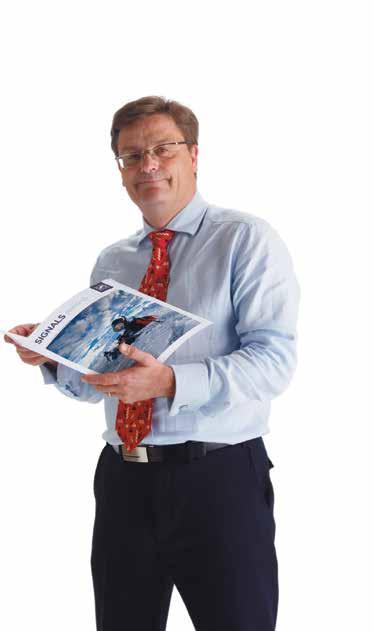
Waves of Migration is a thought-provoking show that weaves together a selection of the rich migration stories that we at the museum have been collecting now for over 20 years.
Our light show was a first on several counts. It’s the first time any museum has combined stories from its collections to create a digital exhibition on such an enormous scale. Our canvas was the iconic roof of our unique museum building, designed by Philip Cox ao to evoke sails and waves. At over 1,700 square metres it is surely the largest continuous projection surface in Australia. The show went live on Australia Day and screened each night for the rest of the summer for the crowds that pour across the Pyrmont Bridge into Darling Harbour – and everyone in the city with a line of sight on our spectacular building. With 44 percent of our 22 million population born overseas, or having a parent who was born overseas, Australia is truly a multicultural country. Since 1788, close to
10 million settlers have moved from across the world to start a new life in Australia –the majority by sea. The many waves that brought them here swept across our roof in this light show. Their human potential has shaped and enriched Australia.
The Australian National Maritime Museum considers these migration stories to be an incredibly important part of our history that we tell through the objects in our collection and also through our Welcome Wall, representing over 20,000 families who have arrived in Australia from countries all over the world.
As we headed towards Australia Day last January, we thought it crucial to look back through that lens of history. We were delighted at the number of guests who responded to our invitation, parliamentary representatives and cultural administrators, and a strong international roll call from the diplomatic community. We were equally honoured to have with us two people whose migrant stories appeared in our light show: Jean Lederer, whose family fled Nazi-occupied Austria in 1938, and young Hedayat Osyan, who was recently forced to leave his family behind as he fled Afghanistan for his very life.
You can read both their stories in the following pages of this edition of Signals, which comes to you this autumn with a new look that speaks of the new directions in which we are taking the Australian National Maritime Museum. On a larger scale, beaming onto our rooftop this summer, the infrastructure and technology that we installed in order to make Waves of Migration possible demonstrate our aspirations to push the boundaries of the newest communication technologies. That will help to ensure the museum can continue to reach out to all Australians to tell the nation’s important maritime stories.
Kevin SumptionThe museum’s innovative roof-top light show illuminates stories of
Samuel Hood photographs capture a family and their fleet of doomed, giant sailing
Who was the lady with flair posing elegantly on a visiting Dutch warship?
This exhibition puts you in the shoes of a rescuer: do you have what it takes to be a hero?
Stunning images of the last great wilderness, above and below the ice, in this new exhibition
Annual MMAPSS grants fund an exhibition on a curiously named riverboat … and much more
Your
This
Graeme’s
– a local legend inspires this private re-creation of a ship of
Rural flood boats are among the new additions to this vital national
The Trixie Forest collection – memorabilia of a
Barbary
Saltwater
cover: Videographer
Canoes


The museum roof burst into light this summer with a unique presentation of migration themes represented in our collection. Kim Tao, the museum’s curator of post-Federation immigration, introduces two special guests who were with us for the launch of our light show Waves of Migration – and whose stories feature in it.
SETTING THE AUSTRALIAN NATIONAL Maritime Museum apart from many other maritime museums around the world is our focus on social history. We explore Australia’s links with the sea through the lens of people’s experiences, an approach that creates a powerful emotional engagement with our audiences. It is of particular significance to the core thematic area of immigration.
Migration by sea is a key theme in our maritime history and for many Australians the long sea voyage remains a defining narrative of the migrant experience. That was central to our summer light show Waves of Migration that played out so spectacularly across the museum roof. I wrote about its development in the last issue of Signals, and on the first page of this current issue director Kevin Sumption has written of what it means for us as a museum to explore our subject through this innovative new medium.
Here in the following pages we present the voices of two people whose stories not only appear in the light show, but who were with us for its premiere on 24 January. One of them is Jean Lederer, who spoke to the audience that night about her family’s experiences as they escaped Nazi-occupied Austria in the 1930s on the liner SS Orama, carrying the few precious possessions that connected them to their homeland.
Jean and her husband Walter later donated these possessions to the museum, adding to our strong holdings about Jewish refugees
and the many others who were part of the enormous post-World War 2 migration from Europe and Britain on the large migrant liners. Over the years we have told many of these stories in our exhibitions.
But the history of seaborne migration did not end with the last passenger liners. It is a history still in the making as asylum seekers fleeing recent conflict in the Middle East and Sri Lanka make dangerous boat journeys to Australia. One of the priority areas identified in the museum’s Collection Development Policy is to document the experiences of seaborne refugees and asylum seekers, as well as political and public responses to them.
The museum holds a rich collection of material representing refugees from the wars in Indochina, which includes the restored Vietnamese fishing boat Tu Do (Freedom) that carried the Lu family to Darwin in 1977. Tu Do made an appearance in the light show. Museum staff have worked closely with the Lu family to tell their stories and to personalise the Vietnamese exodus by providing our visitors with a compelling insight into the nature of refugee journeys.
The museum also has a developing collection related to more recent asylum seekers and people smuggling, and a growing archive of oral histories that explore the migrant experience, the emotions of leaving a homeland and the process of becoming part of a multicultural Australia.
The other guest at our light show premiere whose story appeared in it was 20-year-old
The history of seaborne migration did not end with the last passenger liners ... it is a history still in the making
Afghan refugee, Hedayat Osyan. In 2012 I conducted an oral history interview with him. Hedayat donated a traditional Hazara handkerchief to us – a gift from his sister that he carried in his pocket during his escape from Afghanistan to Australia in 2009. It was one of his few personal possessions, a tangible link to his family and homeland. With his oral history, it is a valued addition to the museum’s collection. An edited extract from the oral history appears on the following pages.
During our interview Hedayat spoke powerfully of his gratitude for the freedom, equality and opportunities available to him in Australia. He embarks on a university degree in Asia-Pacific studies this year and hopes to one day be reunited with his mother, sister and brother. Hedayat’s story reminds us that Australia’s immigration history is living and evolving, and that the Australian National Maritime Museum plays a vital role in collecting, documenting and interpreting this history as it unfolds.
01 Steamship Changsha carries non-European migrants during the period of the White Australia policy. Waves of Migration was developed and written by museum staff working with architectural projection specialists from The Electric Canvas. 02 ‘Ten-pound Poms’ were among those in the last wave of migrants to arrive by ocean liner. Photography by Andrew Frolows/ANMM

They came with very few possessions, and a cardboard box containing documents, correspondence and the key to their homeJean Lederer
Jean was the guest speaker at the public launch of Waves of Migration in January this year.
I NEVER THOUGHT IN MY LIFE THAT I would be standing here to talk about my family, the Lederers, but first I want to thank the maritime museum for bringing history to life. First you published our story in your recent book 100 stories from the Australian National Maritime Museum, getting it spoton about the Lederers’ escape from Vienna, and now it’s in your new light show. I want to thank the whole team of the maritime museum for doing it so well.
Arthur and Valerie Lederer and their son Walter came to Australia in 1939 on the Orient liner SS Orama with very few possessions and a cardboard box. It contained documents, correspondence, and the keys to their home and business, and my knowledge comes from the stories Walter told me about each and every item in the box. You see, Walter became my husband.
Valerie Lederer was a gracious woman and although their entire belongings were lost in the war, she brought with her trinkets that were precious to her. They included the key to the house and a teeny little heart-shaped cardboard brooch that was the very first gift Walter ever gave her. Walter was born with a silver spoon in his mouth and Valerie brought that spoon with her.
To narrow down the history of the Lederer family, I have chosen two highlights.
Arthur Lederer had a business making regalia uniforms and formal outfits for royalty, nobility and famous people around the globe. His clients included Hungarian
counts, the Knights of Malta, the Prince of Japan, the Maharajah of Jaipur in India, King Farouk of Egypt, the Vatican, the Vanderbilts in America; each is a story of its own.
Back in the 1930s there were no photocopying machines. So Arthur Lederer had photos taken of some valuable documents, thinking wherever he ended up he would start up again. One document refers to an order by Franz Joseph, Emperor of the Hungarian-Austrian Empire, for a field marshal’s uniform as a gift to King Edward VII of England.
Why am I telling you this? Outside our Conservatorium of Music here in Sydney, on Macquarie Street, there is a statue of King Edward VII on a horse in a uniform. Every time we drove past, we elbowed each other and said ‘Is that the uniform?’
At the time the Lederer family was trying to leave Vienna because of the German occupation, Arthur wrote to his exalted customers from around the world, asking them to invite him into their country because the bureaucraçy made it impossible to get exit papers. They all wrote back ‘Sorry, but good luck’.
Arthur Lederer wrote a poem in June 1939 while still in Vienna and it is titled ‘Doors’. The poem is highlighted in the museum’s book 100 Stories. The gist of the poem is that some doors are friendly and some are grey and uninviting … and he hoped his doors would always be welcoming.
To my romantic mind I felt he had written this poem under dire circumstances, in 1939 under German occupation, disappointed that none of his customers had offered to help. However, to my delight, a ballet choreographer called Carol Maddox noticed that poem in the Lederer showcase here
01 Opening night: Hedayat Osyan and Jean Lederer (front row) at the light show launch, flanking the show’s curator Kim Tao.
02 A simple keepsake embodied powerful links to the home they were forced to flee. ANMM Collection, gift from Walter and Jean Lederer donated through the Australian Government’s Cultural Gifts Program
03 Scenes from the Lederer family’s departure from Nazi-occupied Austria.
at the museum. To my everlasting happiness she choreographed a ballet dedicated to this poem. She had a door on the stage through which the dancers danced. The performance took place in the Glenbrook Theatre, to a full house!
On the ship to Australia, Arthur Lederer sent a Marconigram (telegram) from ship to shore to the Maharajah of Jaipur, to advise they were passing through Colombo in Ceylon, now Sri Lanka. Walter told me that the Maharajah welcomed them and took them to lunch. They were seated at a long table and behind each guest there was a male servant in livery. Luxury sublime!
Do you remember in the movie The Sound of Music, when the Von Trapp family sang their farewell song on the stage of the Salzburg Theatre? Well back in 1935, the Lederers were on holiday in Salzburg and Walter as a young boy stood in the doorway and collected autographs of the famous people performing at the Salzburg Festival … people such as Toscanini, Fritz Kreisler, Bruno Walter, sopranos and tenors from the Milan Opera. These autographs popped out of the cardboard box and have been placed in a gallery in New York.
Sadly, Arthur Lederer died after one year in Australia. But his wife and son Walter – my husband – integrated quickly and made a life for themselves. Walter married me, a native Aussie. He became a bespoke tailor following in his father’s footsteps and spent most of his spare time doing benevolent work here in Sydney.
I had better round off here. I wish the maritime museum every success with the light show. I thank you all for listening and I thank the museum for giving me this honour to address you.


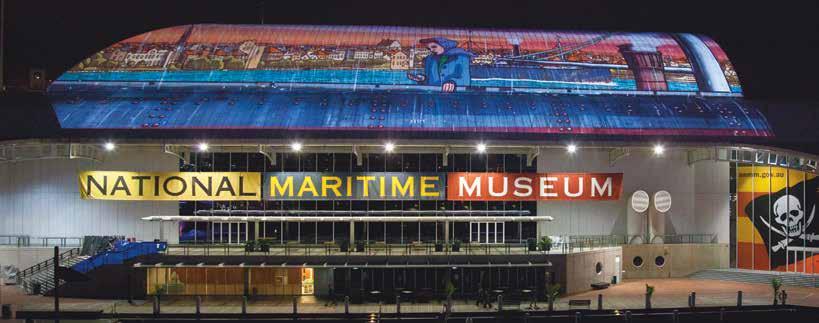
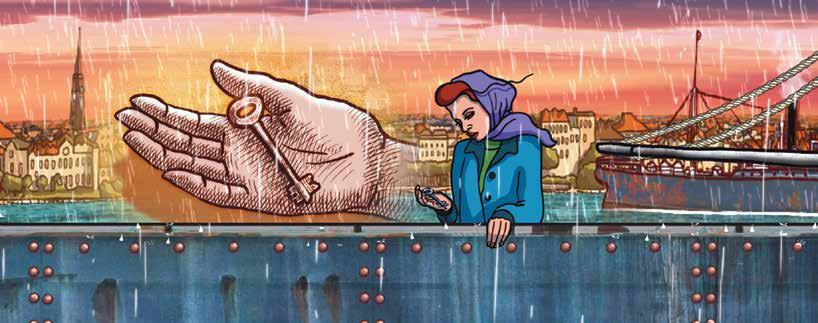

Hedayat
During our interview
Hedayat spoke powerfully of his gratitude for the freedom, equality and opportunities available to him in Australia
Hedayat is a member of Afghanistan’s Hazara minority, who have a long history of persecution by the country’s dominant ethnic groups. After the Taliban took his father, he was forced to flee for his life.
I WAS BORN ON THE FIRST OF J UNE 1992 in Ghazni province, in the centre of Afghanistan. I moved between Kabul and Ghazni province studying at high school. I have a sister, 16, and one small brother, 14. My mother worked at home, my father was a teacher at high school. He was kidnapped by the Taliban and disappeared in 2006, because he was working for the government. The Mujahideen and the Taliban have power still in Ghazni, especially in the countryside where I lived, and because of my [associations] they tried to arrest me and kill me. Although I was responsible for looking after my family I had to leave everything, I had no choice. I was 16. It was 2009.
I hid in Kabul for about two months. Some friends in Iran and Pakistan provided some money to take me to Indonesia. I came by plane from Kabul to Dubai, and then to Malaysia. From Malaysia to Indonesia took three days and nights by boat; we had no food, no drink. It was very hard. When we landed in Medan [Sumatra], the Indonesian authorities arrested us because we had no documents. So they put us in jail for one month.
The jail was a small room, a small house, we were 15 people there and we hadn’t enough food or drink. We had to buy more from the guards. There was just a small toilet, we had to shower in there, and we were not allowed to go outside. I realised that if I stayed here there’s no time limit, there’s no way to put in our application
for UNHCR. We had to escape. We broke through the window during the night when it was raining and the guards couldn’t hear us, and hid in the jungle for five days. One of us had a phone and we contacted an Indonesian lady in Medan who took five of us to Jakarta.
We stayed for six months in a small house we rented, in Bogor [near Jakarta], there were also people from Iran and Sri Lanka. I had only a hundred dollars, not enough money to give to [people] smugglers. They said, ‘You don’t have money, we don’t want to take you.’ Other people went by boat to Christmas Island. I just stayed there until some of my friends working in Pakistan and Iran lent me more money, they sent it to a smuggler’s agent in Pakistan. The price for me was US$7,000.
First the smuggler took us from Jakarta to Mataram [in Lombok, eastern Indonesia] by plane. We stayed there for two days in a small house. One night the smuggler came and took us to the boat. We walked for one hour, in a small group [of] about 45, two families, young children, but a lot of young people like me, by themselves. It was December 2009.
There were no officials, no-one in uniform but definitely some police were there. There was no wharf, we went out to our boat in small canoes. The smuggler [had] said, ‘We have a big boat and safety jackets, food, drink, fruit, everything.’ But when we got to it there was a small fishing boat, it was very old and the engine was very small. We had to sit like this [with knees to the chest]. There’s no safety jacket, there’s no toilet. Everyone was shocked. How can we get from here to Christmas Island? I thought it will break down on the second day. But we had no choice. If we tried to negotiate the smuggler would leave us and the police would catch us. We had to stay calm.
I don’t know anything about where this fishing boat was built or when, it didn’t have a name. It was very old, very poor condition, it was grey. There were a lot of cockroaches. It was smaller than that [points to ANMM Vietnamese refugee boat Tu Do, 18.25 metres]. Very small and not too high. We couldn’t put our legs out straight. There’s one small cabin in the front, the captain was there, and around 15 people, the rest were in the back. No beds, no seats, no galley or kitchen. No toilet, just [had to use] the back of that boat. On board I had just one friend. He was in the back, I was on the front.
The engine made too much smoke. Everyone had to stay inside, we couldn’t move and it was very hard. Everyone was sick, everyone was vomiting. In Afghanistan we don’t have water or boats, so everybody got sick. The engine was very noisy, very old, small, and after six hours, seven hours, it would stop for half an hour. They had to put in some oil. One time the captain jumped in the water and went under the boat to fix it.
We didn’t bring any food on board because we hadn’t anything to take with us. I had a small, small bag. Every day they gave just one small bottle of water. We were very thirsty, during the day it was very hot. Everyone lost their energy, some were unconscious. They just give us some biscuit, and some kind of bread, that’s it, just once every day at 11 o’clock. Some people couldn’t eat that food, couldn’t eat for days. Vomiting. There was nothing inside, just vomiting. After three days in the boat some people went crazy and tried to jump in the water. We caught them and tried to calm them down.
It was a seven-day voyage. We didn’t stop anywhere else in Indonesia. We didn’t see any other boats because we just stayed inside, we were not allowed to go out.
The water was leaking inside too much. We thought, if the Australian Navy or Indonesian police don’t come to rescue us we will die this night


We came out from inside after seven days because the captain said we were in international waters, there’s no problem, we can get out.
During the night when storms were coming, the water came inside and everyone was crying and praying, especially the first three nights and days that were very stormy. [December is the stormy wet monsoon in these waters. Ed] The boat was rocking, it was very small and [carried] too many people. Everyone thought, ‘Tonight we will die.’ It was leaky and we had a small bucket, we just divided the people into two, to take turns to get out the water. Even though everyone got sick and hadn’t enough energy to do that. When the rain came, the water came inside from the holes in the roof. Our clothes were wet.
There were just two crew on the boat, the captain, about 50 years old, and the son about 30. They didn’t have a compass or any charts or any satellite technology. No radio. They just steered from the sun. They were quite friendly. Some of us could speak a little Indonesian, but we couldn’t talk with them too much because they were busy and we had to stay inside. The smuggler was paying them very little. They are very poor people and they haven’t got a job in Indonesia. They know if they come to Australia, just once, they would be put in jail for five years. But they’re very poor, miserable.
On the seventh day of the voyage when the engine stopped we thought it was like usual, maybe the oil is finished, but the captain said, ‘The engine is broken, I don’t think
I can fix it.’ We didn’t have any telephones to call somewhere, because when we got to the boat the smuggler took all the mobiles. We stayed for four or five hours, rocking from side to side, everyone was vomiting and crying and the water was leaking inside too much. We thought, if the Australian Navy or the Indonesian police don’t come to rescue us we will die this night. We just thought how to stay afloat in the water, if the boat was sinking, because we had nothing. No safety jacket, no nothing.
At 12 o’clock during the day a plane came and everyone was waving. We found a little bit of hope, maybe they will see us.
After four or five hours we saw the Navy ship appear. First it was very small, it was so far away, but when that ship approached and become bigger and bigger, and when we saw the Australian flag, everyone was crying, really happy to be found alive. Especially the women and children.
Five officers came by small boat and said, ‘Where have you come from, why did you come?’ I was the only person [who] can speak a little English. They listed everyone’s name and they brought some food and drink. After two or three hours, they brought some safety jackets and took five or six people [at a time] to the ship. When everyone was off [the Indonesian boat] sank.
On the Navy ship they searched our bags, our clothes, and gave us some blankets and towels. Everyone had to stay in a small [compartment] in the front of the ship [near] the anchor, which made a lot of noise and we couldn’t sleep. We were five days on the
Navy ship. We were confused and scared. Why didn’t they take us to Christmas Island? Will they take us back to Jakarta?
We arrived at Christmas Island, I think it was the 13th of December. They separated teenagers from the adults, the families. We went first to a big dinner hall, and they gave us some milk and small burger, vegetarian. The interpreter and an officer came [with] forms and they put us in separate block because we were not allowed to talk with others who had already come. Once a day they took us to the ground to play soccer, for one hour. For the rest we had to stay inside. But everyone was very happy. Everything was okay there.
I was two months on Christmas Island. I was in Melbourne in detention for one month. It was for teenagers and families, only 15, 20 people. Every day they took us to the school, they took us to the park, the gym. It was a very happy time. I couldn’t imagine Australia. It was very clean and very peaceful. I never experienced [this] in my life, everyone, everything was very good.
After Hedayat was granted his visa he went to Sydney to join an uncle already there. He attended the Intensive English Centre at Marsden High School in West Ryde, and last year sat his Higher School Certificate. He works with the Hazara Federation helping other refugees settle in, and begins university this year. His mother, sister and brother fled Afghanistan and live as illegal immigrants in Pakistan, but he has so far been unsuccessful at sponsoring them to join him in Australia.
01 Simple, touching images in Waves of Migration convey Hedayat’s story.



The captain’s beloved six-masted barquentine E R Sterling under sail in all its splendour. All photographs from the museum’s Samuel J Hood Studio Collection of some 10,000 glass-plate and nitrate negatives comprising the maritime work of this versatile photographer whose career spanned the first half of the 20th century.
A trail of misfortunes destroyed Captain Edward Robert Sterling’s beloved fleet of giant sailing ships. Curatorial assistant Nicole Cama found this story hidden among the vast holdings of the museum’s Samuel J Hood Studio Collection, which records this family of North American shipowners and their links with Australia.
IN THE EARLY 20TH CENTURY, photographer Samuel J Hood was discovering new ways to make his mark in an industry that was only just gaining momentum. His tactic was simple but effective – he would take his trusty Folmer & Schwing Graflex camera to Sydney Harbour to photograph vessels and their crews. Before his later career in photojournalism flourished, he relied on the income from portraits he took of captains and their families.
One of the families he photographed was that of Captain Edward Robert Sterling, an American shipowner and sea captain with Australian interests. Over the years, Hood documented their lavish lifestyle, which seems to come alive through his camera lens for viewers almost 100 years later. What these photographs cannot show, however, are the tragic events that were to unfold shortly after the images were taken. This is the story of a family who experienced the high life and had it snatched away, and of a man whose undying passion for the great sailing ships was crushed by financial ruin as his beloved fleet, one by one, fell victim to merciless seas and the Great Depression.
Captain Edward Robert Sterling was born on 3 October in about 1860 in Sheet Harbour in Nova Scotia, Canada.
From an early age he was exposed to the sea; growing up in a coastal town, his love for seafaring would have developed as he watched sailing vessels of all types come into port. According to one news report, he ran away from home at the age of nine to begin his career at sea, and by 21 he was a captain. At some point after this and possibly before he migrated to the United States in 1883, he married Helen B Watt (b 1866), also from Nova Scotia, and the daughter of a ship’s captain.
Sterling and his wife were based in Seattle, Washington, and had three children: Ray Milton (b 1894), Ethel Manila (b 1895) and Helen Dorothy (b 1896), who was known by her second name. Ray later followed in his father’s footsteps and became captain of the family’s six-masted barquentine E R Sterling. By 1919, Captain E R Sterling was listed as the president and general manager of Sterling Shipping Company in Blaine, Washington.
Throughout the 1910s and 20s, Sterling plied the timber trade between America, Australia and New Zealand. He often made
the journeys himself as captain, along with his family, and it seems that the Sterlings enjoyed their trips to Australia. Hood’s photographs show the family at the races and happily driving and picnicking around Sydney. On 17 December 1916 Ray married an Australian woman, Ethel May Francis, and within a couple of years their daughter, Margaret Francis, was born.
Sterling’s fleet of schooners and barquentines comprised some of the largest timber sailing vessels ever built
The series of intimate portraits taken on board E R Sterling between 1910 and 1925 are Hood’s best photographs of the family. They depict family and crew seated in the vessel’s state-of-the-art saloon which, according to the Cairns Post, moved beyond ‘cramped quarters’ and ‘hurricane lamps’
These were clearly golden years for the family, and the portraits of the captain and crew members illustrate their sense of attachment to the ships of the Sterling Line. Little did they know that a crippling series of disasters awaited the fleet
to a player piano and a gramophone, which Sterling had concealed in the room’s centre table, an ‘ingenious combination’ of music and dining table. These were clearly golden years for the family, and the portraits of the captain and crew members illustrate their sense of attachment to the ships of the Sterling Line. Little did they know that a crippling series of disasters awaited the fleet.
The first occurred in 1922, when on 21 January the Helen B Sterling – a fourmasted schooner that cost Sterling £15,000 and which he named after his wife – was partially dismasted by a gale off the Three Kings Islands, north-west of New Zealand, while en route from Newcastle in New South Wales to San Francisco. Captain G R Harris, in command of the ship at the time, ordered a wireless SOS call to be put out which stated, ‘We are waiting for her to go down’. The message was received by the crew of HMAS Melbourne, who set out in search of the stricken vessel. They sent a message in reply, which simply read, ‘We are certain to find you. Keep good heart’. At midnight, the crew spotted the sinking schooner with the aid of searchlights and launched a rescue cutter with 16 volunteers. All 18 crew and passengers were rescued and all of the Australian naval men who risked their lives were awarded gold medals by US President Warren G Harding. The vessel and its freight, however, were not only lost, they were uninsured, and according to one news report, Captain Sterling claimed he was left with losses totalling £53,000.
The next unfortunate occurrence concerned Sterling’s beloved six-masted barquentine, E R Sterling. On 16 April 1927, the ship left Port Adelaide for London with a cargo of between 40,000 and 50,000 bags of wheat. All was going well until it rounded Cape Horn and encountered icebergs stretching for 500 miles (800 km). After navigating through those, the crew faced a heavy gale north of the Falkland Islands on 4 July and the barquentine was partially dismasted. With only four masts remaining, Captain E R Sterling made the fateful decision to sail on and forgo refuge at the port of Montevideo. After crossing the equator at 4 am on 4 September near the Cape Verde Islands, E R Sterling was hit by a hurricane. Four gruelling hours later, the foremast was lost and Chief Officer Roderick Mackenzie was fatally injured as he attempted to rescue the rigging. There was no doctor on board and Captain Sterling tended to the wounded man in his quarters. Two hours later,
the captain read the committal sentences as the chief officer’s body was sent over the side into his watery grave.
SS Norman Monarch eventually answered their SOS calls and offered to tow the vessel into port, but Captain Sterling declined the offer. Instead, he and the crew made their way to Saint Thomas in the US Virgin Islands, in the West Indies. According to the captain’s report, they sailed 2,212 miles (3,560 km) in poor weather and vessel conditions before arriving in port on 15 October. The cargo was transferred to a steamer, then on 15 December E R Sterling began a tow of 4,000 miles (6,430 km) to London, arriving at the Thames in a shambles on 28 January 1928. It had been a horror voyage that took a total of nine months. On 24 March 1928, E R Sterling made its last voyage to Sunderland, where it met its end at the hands of shipbreakers.
Adding to the family’s misfortunes, in May 1926, Sterling had purchased the fourmasted schooner Hawaii, renaming it Ethel M Sterling after his daughter. After it sailed to San Francisco in September 1927, only months after E R Sterling had commenced its fateful voyage, Sterling Shipping Co was forced to sell the schooner because they were unable to pay for the two 240-horsepower diesel engines they had installed shortly after it was acquired. The next event in this tale of woe befell the sister ships that Captain Sterling senior had named after his daughter and wife: the six-masted wooden schooners Dorothy H Sterling and Helen B Sterling (the second ship of this name). Both were built in Portland, Oregon, around 1920 and were originally named Oregon Pine and Oregon Fir respectively. It was reported that Oregon Pine was one of the largest sailing vessels then built, at a cost of £50,000. After a series of unsuccessful voyages, E R Sterling purchased the vessel and changed its name to Dorothy H Sterling in 1928. Again, his ownership was short lived. In 1929, the vessel arrived in Port Adelaide carrying a load of timber from America. Sterling Shipping Co found that they could not pay the harbour dues and crew wages. Consequently, the crew was forced to abandon ship. The vessel was auctioned for a mere £50 to the Harbors Board, which then recouped part of the ship’s debts by selling it to shipbreakers. In 1932, after selling everything of value,
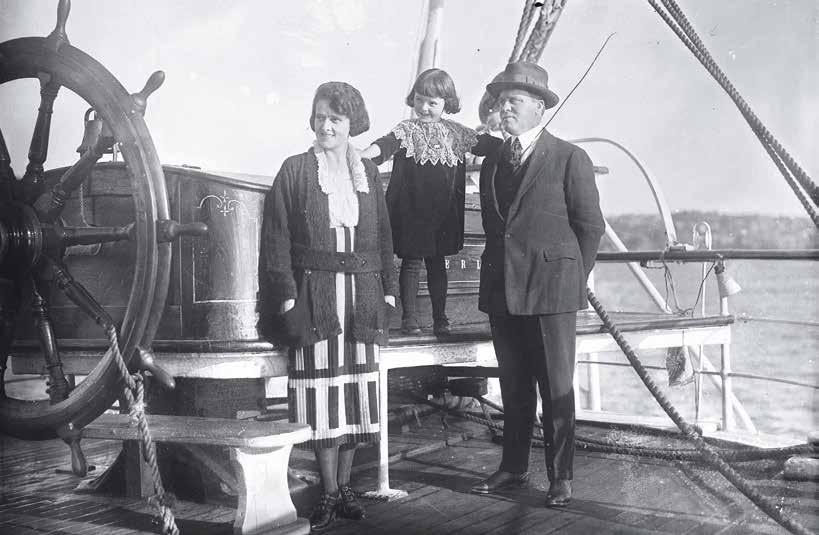
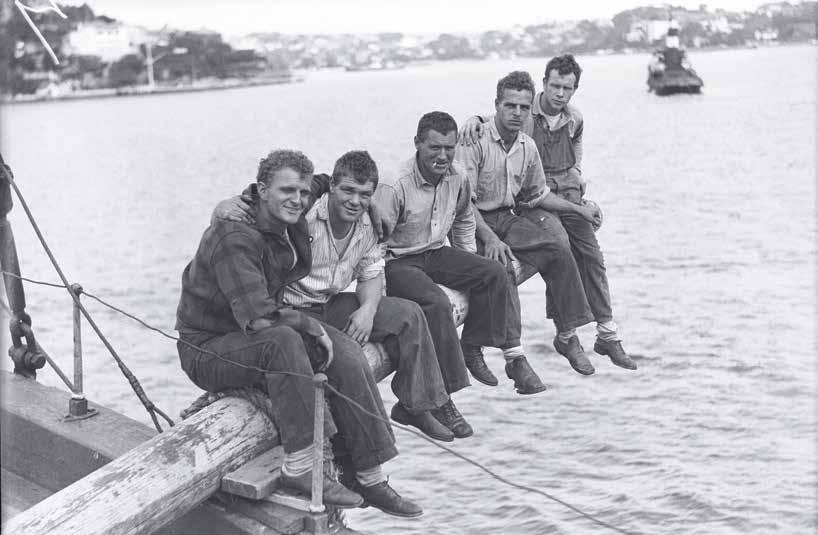
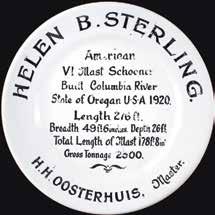

the shipbreakers planned to tow the hull to the Adelaide suburb of Ethelton to be torn apart by the unemployed for firewood. The hull would not fit through Jervois Bridge, however, and it was towed to the North Arm of the Port Adelaide River to be abandoned in the Garden Island Ships’ Graveyard, where the skeleton of its hull remains to this day, a relic of the past.
A similar fate befell its sister schooner, Helen B Sterling (the former Oregon Fir).
In January 1927, Captain Sterling purchased the vessel and, as with Dorothy H Sterling, it made only one voyage under his name, carrying more than two million feet of lumber to Australia. Sterling was forced to sell the schooner to Mr W S Payne of the Pacific Export Lumber Company, who then changed its name back to Oregon Fir
In 1930, the vessel was seized in Sydney for outstanding debts. The ship’s master, Henry H Oosterhuis, reportedly stayed with the vessel for 15 months. As it lay idle in Sydney Harbour, Oosterhuis made headlines in the newspapers for opening the vessel at night as a ‘floating cabaret’ to host wild ‘Bohemian parties’. Sydney Morning Herald journalist Macleod Morgan described the vessel’s final months with a great sense of nostalgia:
Here are the old-timers, such as the Helen B Stirling [sic] , who have seen the greatest days of life, and are now passing their twilight hour in these reaches of the harbour. There they rest placidly amid the ripples, vessels which have helped to build Australia. (SMH, 18 March 1933)
In March 1934, after it was dismantled and stripped of anything of value, Helen B Sterling, as it was still affectionately known, was set on fire in 20 places in its ‘last resting place’, aptly known as Kerosene Bay (now Balls Head Bay near Waverton).
Little information is currently available about what happened between this period and E R Sterling’s death, possibly in 1943.
An article after the E R Sterling disaster states that he had had a ‘long and adventurous seafaring life’ and ‘seemed little the worse for his experiences’ (The Argus, 24 March 1928). Another report in The Mail on the same date described him in one word – ‘heartbroken’. Journalists’ impressions aside, Captain Sterling was a traditionalist. He could not, in his own words, ‘abide steam’, he revelled in the ‘beauty and mystery of the ships, and the magic of the sea’ and he had a profound pride in his vessels and crew. Based on this and the
fact that he named all but one of his vessels after the women he loved most in his life, it seems likely that these misfortunes would have had an adverse effect on him. Captain Sterling was first and foremost a ‘real sailor’, second a shipowner. He had an affinity with the sea and a love affair with the sailing ship that endured all his life. He was of a certain school that bitterly rejected the development of steam-powered vessels as banal and stubbornly stood by his fleet of sailing vessels, with devastating consequences. In the end, Sterling was a man torn between his love for the tall sailing ship and the stark economic reality caused by his unwillingness to embrace the modern age.
Sterling’s fleet of schooners and barquentines comprised some of the largest timber sailing vessels ever built, in a belated attempt to keep sail economically competitive in an age of iron and steam. Their design had distinct pros and cons. They were built to carry enormous bulk cargoes such as lumber, with reduced operating costs thanks to relatively small crews. However, they were vulnerable to harsh weather and were often in port, idle for months on end, waiting to source sufficient cargo to fill their enormous holds.
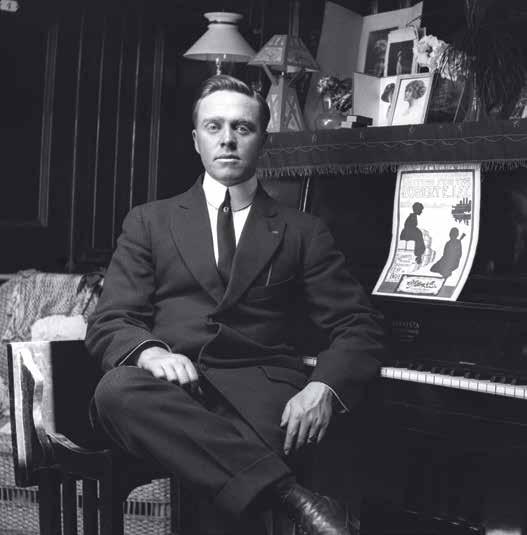
03
E R Sterling was the largest barquentine in the world and the key to its design lay in the gaff sails it carried on all of its many masts, except the foremast. They could be raised, reefed or furled from the deck with the aid of a donkey engine for halyards, enabling ‘10 men to achieve what it would ordinarily take 24 men to do on a square rigger’, as the Cairns Post reported (1 February 1922). Yet although it sailed with some success, E R Sterling lay without charter for months in Adelaide before the 1927 voyage that led to its demise. Similarly, Dorothy H Sterling wasted away in port for months before it was finally sent to Port Adelaide and ripped apart. The small number of crew coupled with these vessels’ size proved a dangerous combination when they encountered bad weather. Despite their majesty, the ships of the Sterling Line have passed into maritime folklore.
The sad fate of the Sterling Line contrasts with Hood’s photographs of happier days, before industrial change and economic hardship took their toll. Amid the heartbreak, Hood’s images hint at stories that may otherwise have been left untold. Discoveries like these not only underline the significance of the Hood collection to Australia’s maritime history, they reinforce
the nature of his photographs. They show a time when ships’ portraits were popular among crew members, before steam superseded sail and the demand for Hood’s portraiture declined. Moreover, they display the human face of sailing that Hood so rigorously pursued. They depict the crew’s camaraderie and the close relationship they shared with their vessels.
Apart from Hood’s photographs and a few objects from the collection, all that remains for us to see today are the barest bones of the Dorothy H Sterling, which appear at low tide in the Port River in Adelaide –destroyed after shipbreakers had ‘wrenched all her beauty from her’, and abandoned to ‘that graveyard of broken ships where the waves lap sadly and the wind sighs mournfully through the timbers of what were once graceful craft’ (The Advertiser, 5 February 1932). The bones of Dorothy H Sterling are remnants of a bygone era; they are mementos of the boy who fell in love with sailing and ran away to sea.
With thanks to Steve Reynolds of The Marine Life Society of South Australia and his work on the Sterling ships, in particular ‘The Schooner Dorothy H Sterling (and other ships associated with her)’, MLSSA Newsletter No 355, June 2008.
This is the story of a family who experienced the high life and had it snatched away, and of a man whose undying passion for the great sailing ships was crushed by financial ruin
01 Ceramic plate commemorating the schooner Helen B Sterling. Henry Oosterhuis was the vessel’s last master. ANMM Collection
02 A day at the races: (right to left) Captain Edward Robert Sterling, his son Ray Milton Sterling and Australian daughter-in-law Ethel May Sterling, with unidentified friends.
03 Captain E R Sterling’s son, Ray Milton Sterling, seated next to a symbol of modern invention, the player piano. The saloon of E R Sterling was reported as most beautiful, equipped with a range of contemporary gadgets built for ‘comfort and convenience’.
As the power of the internet spreads more of our collections wider and wider, online sleuths help museum curators to identify images that have lain anonymous for decades in archives and storage cabinets. Curatorial assistant Nicole Cama writes of one such case.
RECENTLY THE WORLD MARKED FIVE years since the launch of Flickr Commons, an online image-sharing facility that has been embraced by many museums as a way of getting their holdings out to a wider audience – and tapping into a worldwide bank of knowledge and enthusiasm. In those five years, about 250,000 images from the photographic collections of 56 different libraries, archives and museums – including some of our own – have been uploaded. Audiences around the world have embraced the spirit of The Commons, putting their own time and energy into researching people, places and key events in previously unidentified images.
Here is one of my favourite photographs from the museum’s Samuel J Hood Studio Collection – the Sydney photographer whose work appears on the previous pages. For me, it’s one of the most beautiful portraits I have seen, and we published it in Signals No 100 last September (page 25) even though the identity of this stylish young woman had remained a mystery as I researched that story. She was part of Sam Hood’s coverage of the October 1930 visit of a Dutch warship, HNLMS Java, and an onboard reception that attracted the cream of Sydney’s fashionable society. Time and time again I would go back to this photograph, trying to spot the elusive clue that would lead to a name and then, hopefully, to a story. I wasn’t alone.
Ever since we posted this image on the photo-sharing website Flickr Commons, it has had users spellbound. So imagine my delight when one of them, doing their own research recently, stumbled across her name and let me know! They had found the answer on page 52 of the November 1930 edition of The Home quarterly magazine, which had first published our Samuel Hood photographs depicting that reception on HNLMS Java
She was Miss Hera Roberts, Sydney painter, designer, illustrator and socialite. A 1929 advertisement described her as a lady with ‘amazing flair’, and her appearance in The Home was no coincidence. Hera designed and illustrated more than 50 of its covers and was considered an arbiter of taste when it came to interior decorating. The Home, subtitled Australia’s ‘Journal of Quality’, was dedicated to all that was sophisticated and à la mode in the world of art, interior design and fashion, during an era marked by the bold and modern exuberance of Art Deco.
Hera Roberts was also a muse to many of Australia’s most talented artists and photographers. Max Dupain and Harold Cazneaux both captured beautiful portraits of her, and Thea Proctor, her cousin and one of Australia’s most renowned female artists, also paid homage to Hera in her work The rose (1927). George Lambert painted what for me is the most beautiful portrait
of her, in 1924. The work, reproduced here courtesy of the National Gallery of Victoria, depicts a youthful Hera in a pose strikingly similar to Hood’s photograph, hand on hip, neck craned to reveal her slender figure.
These portraits echo the theme behind many of her Home journal covers: the modern woman should be elegantly though nonchalantly poised. The Sydney Morning Herald of 13 November 1929 quotes her directly: ‘More than ever … is the search for personal beauty essential in the modern world where Beauty is demanded on every side – the underlying motif for comfort and harmony. Isn’t there an old Greek adage–“Beauty is the gift of Nature, but beautiful living is the gift of Wisdom”? ’
This world of Sydney fashion and aesthetics has been opened up to us, firstly through a glass-plate negative from our collection of the life’s work of that talented photojournalist Samuel J Hood, and then courtesy of one of the super sleuths of Flickr Commons. So to our helpful online researcher who goes by the username ‘quasymody’ … thank you!
01 Hera 1924 by George Lambert, oil on canvas. National Gallery of Victoria, Melbourne. Felton Bequest 1925
02 Hera Roberts at a reception on board the Dutch light cruiser Java moored in Circular Quay, Sydney, 10 October 1930. Samuel J Hood, ANMM Collection.

Time and time again I would go back to this photograph, trying to spot the elusive clue that would lead to a name and then, hopefully, to a story


Navigating through a choppy swell, communicating under thunderous chopper blades, conquering your fear of heights … our new interactive exhibition Rescue, from Scitech in Western Australia, encourages visitors to develop a deeper understanding of the science and technology used in a rescue. Do you have what it takes to be a hero?
SEARCH AND RESCUE OPERATIONS TAKE place every minute, every hour, every day, all around the world. Whether in the air, on sea or on land, these services are lifelines to countless people in times of need. But what does a rescue really involve? Who are the teams that put themselves in these dangerous situations? And would we know what to do if we found ourselves in need of rescue?
Rescue, from Western Australia’s Scitech, gives families the opportunity to experience and react to high-pressure rescuebased scenarios where people’s lives are potentially at stake in land, sea and air rescues. Museum visitors can take part in ‘rescues’ as either the rescuer or casualty. By putting themselves in both positions, they can learn how rescue technology works and also how the skills and experience of talented rescuers assist people in peril. Visitors can try pulling themselves out of a simulated sea of blue plastic balls onto a real life raft, and feel what it’s like to clamber aboard when the raft tips and shifts in the chaotic surroundings. Or they can step into the shoes of a helicopter team as they climb aboard a life-sized helicopter and fly a simulator, while using an infrared camera to search around the exhibition.
Dramatic advances in technology mean that rescues are now faster and safer than ever before. Breathing apparatus has transformed the work of firefighters, radio beacons are fundamental in locating missing persons and infrared cameras allow rescuers to spot casualties even at night. The exhibition integrates examples of rescue technology,
01 Specialist operations by EMQ Helicopter Rescue, Queensland Department of Community Safety. Photograph supplied courtesy of exhibition major partner, the Australian Maritime Safety Authority.
02 A life-sized helicopter allows visitors to fly a simulator and use an infrared camera to search around the exhibition. Photograph courtesy of Scitech

Dramatic advances in technology mean that rescues are now faster and safer than ever before
What does a rescue really involve? And would you know what to do if you found yourself in need of rescue?

such as jetskis to simulate the rescue of a swimmer in danger, or the ‘jaws of life’ that can cut apart a car to rescue an accident victim trapped inside.
Recent natural disasters such as the 2009 Black Saturday fires and 2011 and 2013 Queensland floods are strong reminders that rescues would be impossible without the brave people who perform them.
‘Rescue is a very human endeavour, so this exhibition focuses on the personal aspect of rescuing people as well as revealing the technology and equipment that support the process,’ the museum’s director, Kevin Sumption, says.
The exhibition is suitable for children from five to 12 years and their carers, and encourages whole-family interaction and teamwork through interactive exhibits. Primary-aged school students particularly will benefit from interacting with exhibits that involve collaboration and assistance in physical rescue situations. Secondary students will be able to explore more complex rescue concepts through exhibits
involving search patterns and wave rescues. There is also a school program tailored to students from eight to 12 years, which challenges them to identify particular examples of rescue technology in the exhibition and find out how they work or what they are used for.
Rescue operations require a high level of training and are undertaken by specialist squads who often push themselves to extremes both physically and mentally. Visitors to Rescue are encouraged to put themselves in the shoes of a rescuer and examine their own reactions and feelings. They can take command of a search team to map out a route to find a missing bushwalker, or walk across a balance beam perched above a simulated raging ravine to understand how rescuers must often overcome their own fear to save others. Above all, the exhibition emphasises that despite all the advanced technology available to rescuers, rescue depends on humans, and their skill, co-operation and bravery.
Rescue runs from 16 March to 14 July 2013 in the museum’s Gallery One, and is suitable for children from five years and their carers.
Want to hear about a real-life rescue?
Join us on Tuesday 16 April, when Captain Mike Taylor of Orion Cruises talks about his rescue of solo round-the-world sailor Alain Delord after his yacht was dismasted in the Southern Ocean. See page 40 for details.
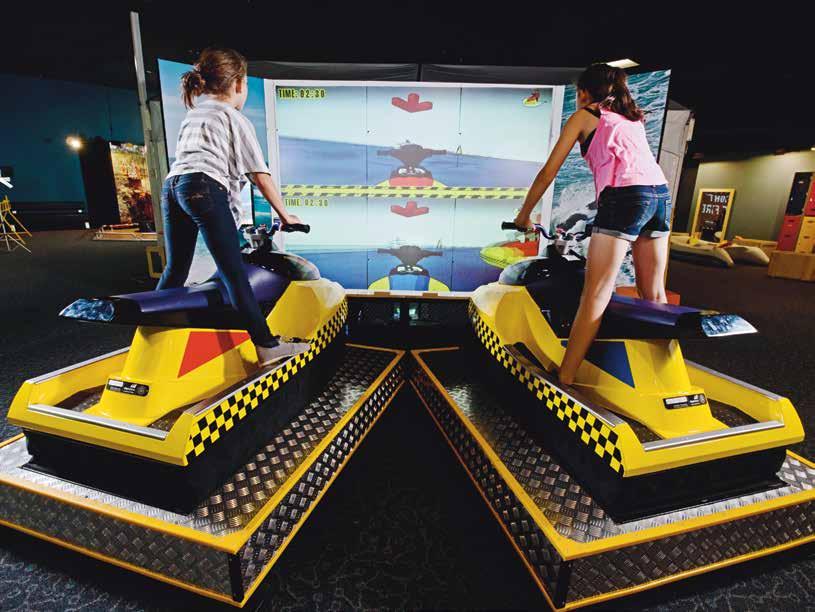

01 Crossing a narrow beam over a simulated deep ravine gives an idea of how rescuers have to overcome their own fears to save others.
02 This interactive challenges visitors to navigate jetskis around obstacles to rescue a swimmer in trouble – in just three minutes.
03 In a sea of blue plastic balls, visitors can get a feeling for how difficult it is to climb aboard a raft in heaving seas.


A new exhibition, Elysium Antarctic Visual Epic, captures stunning images of this last great wilderness, documenting life above and below the ice, the fauna and flora, glaciers, and magnificent land and seascapes.


I N 2010 A TEAM OF E x PLORERS comprising wildlife photographers, filmmakers and scientists embarked on an expedition from the Antarctic Peninsula to South Georgia, in the footsteps of Sir Ernest Shackleton’s famous Endurance expedition. Their mission was to scout, record and analyse this land of ice and snow and to produce a feature documentary, a book and a visual library of the impact of climate change on the southern polar region.
The 57 members from 18 countries, convened by Australian project director Michael Aw of the Ocean Geographic Society, included some of the world’s most celebrated artists, photographers, filmmakers, musicians and scientists.
Its aims were to document the flora and fauna of the region; to record the diversity and biomass of its animals, glaciers, land and seascapes; to produce a feature documentary and book to commemorate the 100th anniversary of Shackleton’s Imperial Trans-Antarctic Expedition; and to establish an image database to serve as a reference index of the Antarctic Peninsula and South Georgia. It also hoped to make landfall on Elephant Island, where
22 of Shackleton’s men were stranded for four and a half months (see story opposite page) while Shackleton and five others sailed away in search of help.
The route of the expedition – from Ushuaia in Argentina, through the Weddell Sea to the Antarctic Peninsula, then across the Drake Passage to South Georgia and back to Ushuaia – approximated that of Ernest Shackleton and his crew after their ship Endurance was crushed and sunk by ice. One of its objectives was to document the sounds and sights of the region that Shackleton’s explorers would have seen.
The expedition sailed on Professor Molchanov, a Finnish-built oceanographic ice-class research vessel refitted as a passenger ship. It set off on 13 February 2010, entering the normally treacherous Drake Passage in calm conditions just after midnight. On Shackleton’s birthday, 15 February, the ship reached the Melchior Islands, encountering fur, Weddell, leopard and crabeater seals, humpback whales, and birdlife including skuas, blue-eyed shags and Arctic terns. The next day at Pleneau Bay, a few fortunate photographers were able to interact underwater with a couple
Elysium Epic is about extraordinary explorers using advanced imaging technologies to document the last wilderness on our planet
01 Previous pages: Adélie penguins, Petermann Island, Antarctica. Photographer Michael Aw. Photographs courtesy of ElysiumEpic.org
02 Leopard seals, Astrolabe Island, Antarctica. Photographer Steve Jones
03 Antarctic fur seals at Fortuna Bay, South Georgia. Photographer Jenny Ross
04 Fortuna Bay, South Georgia. Photographer Ernie Brooks

SIR ERNEST S HACKLETON’S Antarctic journey of 1914–16 is regarded by many as the most remarkable rescue saga in maritime history. The aim of his Imperial Trans-Antarctic Expedition was to be the first to cross Antarctica coast to coast via the South Pole. The expedition’s two ships were Aurora, under Captain Aeneas Mackintosh, which was to head to the Ross Sea and establish supply depots, and Shackleton’s ship Endurance
A 144-foot (44-metre) three-masted barquentine, Endurance was built in 1912 as a tourist ship for polar-bear hunts, and christened Polaris. Possibly the strongest wooden ship ever built, it was designed and constructed specifically for polar conditions. It was later bought by Shackleton, who renamed it Endurance after his family motto Fortitudine vincimus – ‘By endurance we conquer’.
Shackleton’s 27 fellow explorers set sail from Plymouth, England, in August 1914. In Buenos Aires they picked up Shackleton, who had been delayed in England on expedition business, then sailed on towards Antarctica. In late January 1915, in sight of land,
Endurance stuck fast in the Weddell Sea ice. The ship drifted with the floes for months until, in early October, the movement of the thawing ice began to crush the hull. Supplies and three lifeboats were transferred to the ice, and the crew settled down to wait. Endurance sank on 21 November, stranding the crew with no hope of rescue in the windiest, coldest, most uninhabitable place on earth.
For five months, Shackleton and his men camped on the ice, surviving on penguins, seals and sea birds, and marching more than 100 kilometres dragging their lifeboats laden with supplies. In April the ice floe they were camping on broke in two, and Shackleton decided that they should put to sea in their three small lifeboats and search for land. After seven days at sea, pinpoint navigation landed them 556 kilometres away, on Elephant Island – an inhospitable place far from any shipping routes, and a very poor location to wait for rescue. So, on 24 April 1916, Shackleton and five of his fittest men set sail for South Georgia in a 20-foot boat, surviving the 1,300-kilometre journey across the world’s most treacherous
ocean – a journey that was re-enacted by six expeditioners from Australia and Britain earlier this year, led by Tim Jarvis. Their gear and clothing were authentic to Shackleton’s period, and they sailed an exact replica of Endurance’s lifeboat James Caird
On South Georgia, Shackleton and two companions trekked for 36 hours across mountainous terrain to the tiny whaling settlement of Stromness, from where Shackleton began to organise a rescue. The first three attempts failed, but on 30 August, a seagoing tug lent by the Chilean government rescued the men on Elephant Island, where they had been stranded for four and a half months, and took the entire crew back to Valparaiso, Chile, and civilisation.
The entire ordeal had taken more than 20 months, but despite the dangers and privations, not one of Endurance’s crew was lost. Their support party was not so lucky; Aurora successfully established depots on the Antarctic continent for the Endurance expeditioners, but three sailors died in the attempt.
The Antarctic Peninsula is regarded as one of the most enchanting regions of our planet, yet it is fragile, volatile and under severe threat from global warming
of boisterous leopard seals. There, as the weather closed in, explorers in Zodiac inflatable boats observed masses of krill leaping from the water to avoid the vessels.
On following days, the underwater team documented nudibranchs and crustaceans, and managed more close encounters with leopard seals, which have a reputation for ferocity that was not borne out by the expeditioners’ encounters with them.
The underwater photographers also documented the behaviour of Antarctic fur seals both above and below the water, including unusual activities such as a seal catching and killing an Adélie penguin.
As well as abundant wildlife, the expeditioners encountered something much less common to Antarctica: rain.
The principal expedition scientist and chief scientist of the Australian Antarctic Division, Dr Steve Nicol, commented that in 25 years of surveying Antarctica, this was the first rain he had experienced. Rain is a sign of global warming; while it may encourage plant life, it is probably detrimental to the health of many of the breeding birds, which get damp and cold. Increased atmospheric moisture also results in more snow falling, and this too can affect birds if it falls during their incubation period, burying their eggs. Other signs of climate change were seen at Cuverville Island in the presence of two plants, a moss and a grass, that are crucial indicators of warming weather.
The science of this expedition centred on plankton and how it is being affected by climate change. Plankton, along with krill, is a major food source for many marine animals and plays a vital role in the Antarctic ecosystem. It appears that the jelly-like marine herbivores called salps are becoming more abundant in the Southern Ocean due to global warming and are displacing the krill, changing the ecosystem, which in turn could affect many other creatures right the way up the food chain. The expedition collected krill and salps in the West Antarctic Peninsula and South Georgia regions, then froze them in liquid nitrogen for later DNA analysis, which will show whether the populations in the two areas are connected.
A highlight of the trip was managing to land all of the expeditioners on Elephant Island, where 22 of Shackleton’s crew spent more than four bleak months awaiting rescue. The island is home to colonies of chinstrap and Adélie penguins, and several fur seals. When Shackleton and his party arrived here, there would have been no seals; hunters stripped these islands of their seals in the 18th and 19th centuries, and the populations are only just beginning to recover.
On the next leg of the voyage, from Elephant Island to South Georgia, the team’s focus was plankton science. They set holographic cameras and plankton nets to sample and record data about these creatures. During sampling sessions, when the ship slowed and the equipment was lowered, it didn’t take long for the ship to be surrounded by albatross, apparently conditioned by fishing boats to expect a free snack.
On 23 February the team landed at South Georgia, where Shackleton’s rescue attempt culminated and where in 1922, just about to start another expedition, he died of a heart attack, aged 47. At his wife’s request, he was buried there. The entire Elysium expedition team gathered for a memorial at his grave, proposing a toast with Irish whiskey to the man who was the inspiration for their journey.
Edited by Janine Flew from Elysium Epic materials. For more about the expedition, see www.elysiumepic.org.
Elysium Antarctic Visual Epic 13 April to 11 August www.anmm/gov.au/elysium
A feature documentary and book about the expedition have been produced. See page 40 for details about a special Members exhibition and film preview, talk and book launch.
Shackleton’s Antarctic Visual Epic (SAVE) will be a visual database established with images taken on the expedition. It will serve as a reference of the Antarctic Peninsula and South Georgia, with a curator appointed to manage the archive and curate new images of the region. This archive will be made available for educational and scientific reference for climate change study.
sponsor

Supporting sponsors
Equipment sponsors:
Seacam
Amphibico
Waterproof
Nikon
Atomic
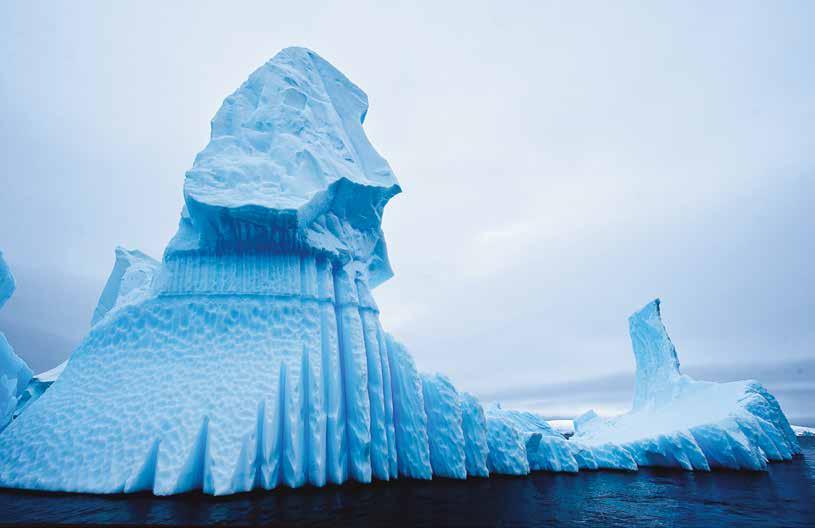

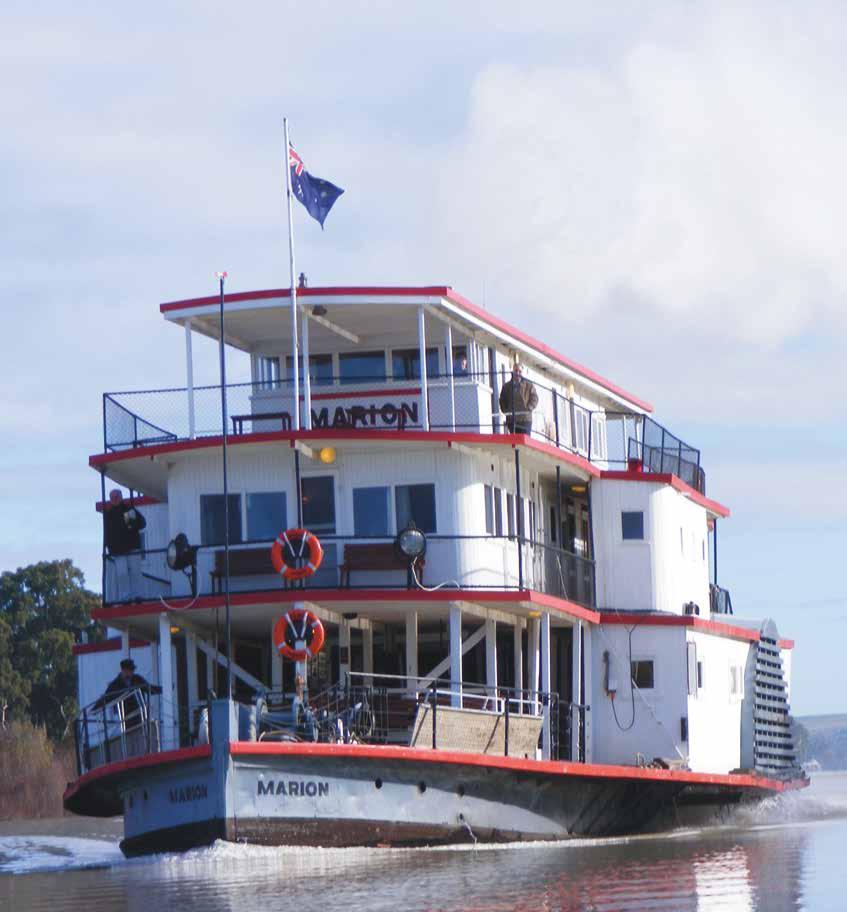
MMAPSS GRANTS AND INTERNSHIPS 2012–13
Do you have a maritime heritage project that would benefit from one of our annual MMAPSS grants or a museum internship?
Find out more about them at www.anmm.gov.au/mmapss
MMAPSS GRANTS AND INTERNSHIPS 2012–13
Our annual heritage-project grants and internships continue to support maritime conservation, research and interpretation around the country. This year, projects range from the construction of traditional Aboriginal bark canoes to a display of Zane Grey memorabilia. One of last year’s grants produced an exhibition on a paddle steamer with the unusual name of The Wandering Jew
ONE OF THIS MUSEUM’S MOST NOTABLE outreach programs is the Maritime Museums of Australia Project Support Scheme (MMAPSS), a generous series of annual grants that contribute towards projects to conserve and promote Australia’s maritime heritage. Administered by us and funded jointly by us and the Commonwealth Government’s Department of Regional Australia, Local Government, Arts and Sport, the scheme provides support and training to regional and remote maritime museums and historical societies – most of them community based and run by volunteers. The main criterion for eligibility is that the organisation or activity is run on a not-forprofit basis.
With the grants scheme is a parallel program awarding internships that bring those community museum personnel to Sydney to work and learn alongside our own staff here at the Australian National Maritime Museum, providing financial assistance for travel and accommodation.
Applications for both MMAPSS grants and internships fall mainly into the categories of conservation, presentation or collection management. The majority tend to be conservation related, since remedial treatment of individual objects is an
essential but frequently costly component of managing a collection. Most regional museums and historical societies do not have access to a fully equipped conservation lab or a team of highly skilled conservators, so often they must engage conservation consultants. The remoteness of many regional institutions is another challenge: objects must either be couriered to the consultant using specialist freight carriers or the conservator must travel to the regional location. Either way, significant expenses can be incurred.
ANMM conservation manager Jonathan London is sympathetic to the challenges faced by regional and remote institutions in maintaining best practice standards. He recommends a ‘prevention rather than cure’ strategy.
‘Although it can be necessary to treat individual objects requiring immediate attention to ensure their long-term survival, a holistic approach to the preventative care of an entire collection is more cost effective,’ he says. This can be achieved by undertaking a survey and developing a conservation management plan to assess the entire collection, its environmental and storage conditions, and its handling and display methodologies. The conservator can
then make recommendations on improving these aspects, as well as suggesting building improvement and integrated pest management strategies. MMAPSS strongly supports this approach and encourages applications for projects focusing on preventative care.
Wandering Jew and Walgett District Historical Society Museum
Paddle steamers played a vital role along the Barwon and Namoi rivers in New South Wales in the 18th and early 19th centuries. The first ever to arrive at the regional hub of Walgett, in 1861, was Gemini, the second steamer of Captain William Randell, who pioneered riverboats on the Murray–Darling with his famous, home-built Mary Jane. The largest steamer to visit Walgett was Excelsior, which was converted to a passenger vessel and only visited once. For half a century, boats like these brought provisions such as fencing materials and furniture to isolated riverside properties and townships, and returned downriver towing barges laden with wool for sale in Sydney or Adelaide.
One of the more frequent visitors to Walgett was Wandering Jew, a paddleboat steamer that travelled the rivers for more than four decades. Wandering Jew began its life
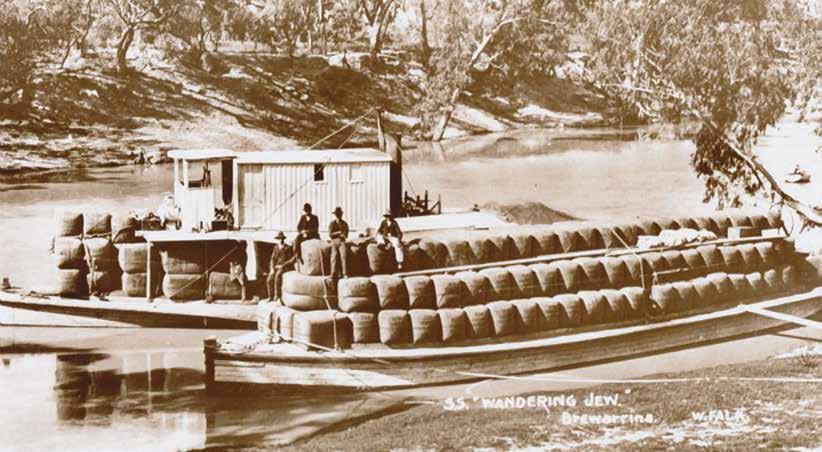
Though its name might now be thought offensive, Wandering Jew was called after a previous owner, a peripatetic Jewish businessman named Daniel Berger who steamed up and down the river in his boat
in Echuca in 1886, registered as Riverina It was 22 metres long, 4.5 metres wide and had a draft of 1.5 metres – unusually deep for riverboats, which generally had shallow drafts, sometimes as little as 50 cm. It was propelled by side paddles and powered by a 10-horsepower steam engine.
The vessel was damaged by fire and subsequently repaired on at least three occasions, in the years 1875, 1883 and 1890. By 1890, the owner was George ‘Nobby’ White, who reduced the boat’s tonnage from 76 to 48 tonnes and renamed it Wandering Jew. This name, which might today be thought offensive, was inspired by the previous owner, said to have been a peripatetic Jewish businessman called Daniel Berger, who steamed up and down the river in his boat.
Under Captain White the boat plied its trade between Walgett and Wentworth, at the junction of the Murray and Darling rivers, although in its latter years it mainly travelled between Walgett and Brewarrina. Captain White married a woman from a station near Brewarrina. Mostly Mrs White lived in Brewarrina, but she travelled on board with her husband when times were tough. On the boat she liked to have some refinement, and two fine coloured-glass vases that she kept on board were proof of this.
Wandering Jew was the very last paddle steamer to visit Walgett, in the year 1912. The old boat finally tied up in the Barwon
above Brewarrina and was used as a floating store until 1914, when fire totally destroyed the vessel. Its skeletal remains rest in the Barwon River mud, and have been covered by water since the Brewarrina Weir was constructed.
The $3,200 MMAPSS grant received by the Walgett District Historical Society Museum in the 2011 round has contributed to an exhibition that examines paddle steamer history around Walgett, focusing on Wandering Jew. The grant enabled investigations into models, and as a result a fine, detailed 1:25 model of Wandering Jew, based on the evidence of early photographs, was made by two members of the Dubbo Wood and Woodturning Group, Paul Nolan and Brian White. They also made a model of the Barwon Inn, where many of the steamers moored when they came to Walgett. The exhibition is displayed at the Walgett District Historical Society Museum, and will be on loan to the town of Brewarrina for its sesquicentenary celebrations in April 2013.
With thanks to Margaret Weber of the Walgett District Historical Society and Nanette Hart (great-granddaughter of Captain George White) for information about Wandering Jew, and to ANMM staff member Sharon Babbage for administering our MMAPSS grants and providing details of the grants awarded.
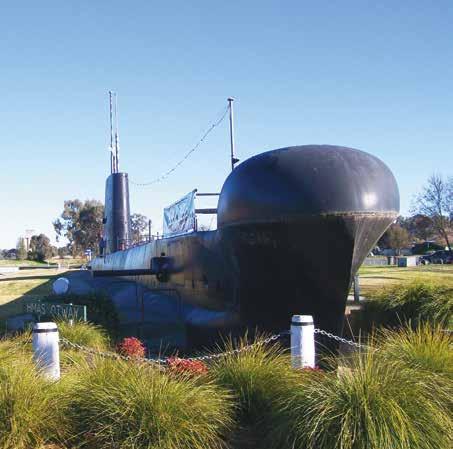

The Maritime Museums of Australia Project Support Scheme is supported by the Australian Government through the Australian National Maritime Museum.
Bermagui Historical Society Incorporated – In-kind support
For the services of an ANMM designer to assist with display cases for an exhibition relating to the famous US pulp-Western writer Zane Grey, who made Bermagui the base for his game-fishing holidays.
Clyde River & Batemans Bay Historical Society
$5,000
For the Canary of the Clyde project. An ANMM curator will assist with developing a conservation plan for a turpentine-wood oyster punt, an artefact that is important to the commercial history of local oyster farming, and for interpretive signage.
Eden Killer Whale Museum
$1,200
For establishing a museum environment monitoring system, through the purchase of six USB data logging units to monitor and adjust the current collection storage conditions at this South Coast fishing port.
Fort Scratchley Historical Society
$8,500
For stage one of the restoration and structural works to the site of the western barbette at Fort Scratchley, the 80-pound rifled muzzle-loading gun and its gun mount, to interpret this important site guarding the entrance to the port of Newcastle.
Holbrook Submarine Museum
$5,000
For the Masts for the Future project, to replace the existing false array of periscopes, snorkels and aerials on the conning tower of this inland town’s Oberon class submarine HMAS Otway. They will be upgraded to original hardware authentic to the class when it was in commission through the 1970s, 80s and 90s.
Jerrinja Local Aboriginal Land Council
$5,000
For the Jerrinja Traditional Canoe Making project, to construct four Aboriginal bark canoes to revive traditional techniques and practices. The council will mentor and work with Aboriginal youth recruited from the juvenile justice system and local schools.
Lady Denman Heritage Complex
$5,000
For conservation of the historic fishing launch known as Crest or Ninon, supporting essential restoration and preservation work supervisrf by a qualified shipwright.
Mid North Coast Maritime Museum
In-kind support
For the Let There be Light project, support will be provided by an ANMM designer to visit, review and provide recommendations on display lighting.
River Canoe Club NSW Inc
$3,300
For the Australian Canoeing and Kayaking Heritage Preservation project, funding for the digitisation component of archival Super 8 and standard 8-mm films.
Tamarama Surf Life Saving Club
$4,000
For the Tamarama Heritage Project, stream two, stage one: for a significance assessment and collection plan, relating to digitising and conserving heritage items.
01 Wandering Jew and barge at Brewarrina. Photograph courtesy Walgett District Historical Society Museum
02 The unusual sight of an Oberon class submarine planted in the municipal park of a NSW country town hundreds of kilometres from the sea. Photograph from Holbrook Submarine Museum
03 Fishing boat Ninon in shipwright Alf Setree’s original boatshed. Photograph from Lady Denman Heritage Complex
Darwin Military Museum $5,000
For a conservation plan for the two 6-inch guns from HMAS Brisbane that formed part of Darwin’s defences during World War 2, so they can be restored for display.
Blackbird International Ltd $10,000
For the Saving Torres Strait Pearls project, to record the history, songs, dances, stories and photographs relating to the pearling lugger Antonia, which is currently undergoing restoration in Townsville.
National Trust of Queensland –James Cook Museum $3,000
For the May-Belle project, for an ANMM specialist to document the lines and develop a vessel management plan for the May-Belle and for interpretation materials (see article on page 50).
Queensland Maritime Museum $3,000
For the World-War-2 era River class Frigate HMAS Diamantina Type 271 radar installation and interpretation project.
Alexandrina Council –Friends of PS Oscar W $5,000
For the project Paddle Steamer and Barge Building at Goolwa 1853–1913, to build on the existing education program for schools and the general public with a digital film documentary on paddle steamer and barge building at Goolwa.
Mannum Dock Museum of River History
$10,000
To design, plan and cost stages three and four of the All Steamed Up project at the Mannum Dock Museum of Murray river steamboat history.
Mid Council/PS Canally Restoration Committee $5,000
Towards the restoration of PS Canally project stage 2, with prior research and development of a vessel management plan.
Australian Maritime College In-kind support
For an ANMM registrar to provide support and assist in researching and recording objects of maritime significance.
Maritime Museum of Tasmania $3,000
For the Surfing in Tasmania travelling exhibition on the history of surfing and surf culture in Tasmania.
Narryna Heritage Museum Inc
$1,500
For a project to conserve the Sir John Rae Reid ship’s portrait and frame, for research into the painter and provenance of the portrait.
Steamship Cartela Trust
$1,500
For the disassembly of Plenty and Sons triple-expansion steam engine, for a member of Sydney Heritage Fleet with experience in vintage steam engines to conduct a survey of the original 1912 engine.
Wildcare Inc Friends of Maatsuyker Island (FOMI) $2,800
To catalogue heritage objects in the Maatsuyker light station, light tower and on the island from the last 121 years of European occupation.
Flagstaff Hill Maritime Village
$9,545
For the Flagstaff Hill Shipwreck Collection Discovery Trail project, to develop video podcasts that will link the existing Heritage Victoria Shipwreck Discovery Trail and detail the links between the actual sites of wrecks and the collection pieces held by the organisation.
Glenelg Shire Council
$8,000
For the Conservation of the Portland Lifeboat project, for essential structural and some cosmetic works on the vessel as identified in the Portland Lifeboat Conservation Management Plan 2010.
Koorie Heritage Trust Inc
$5,000
For the Ganagan (Deep Water) Waterways in Koorie Life and Art project, for content development for an online component complementing a physical exhibition. This funding will allow artworks and associated stories from the exhibition to be featured on the website.
Ross James will apply these skills to the restoration of Cartela, a 123-foot timber river steamer built in Hobart in 1912, in order to keep her operating into her second century
Mallacoota & District Historical Society Inc $5,000
For the Mallacoota’s Sea Mine Field project, for a research project to further develop the interpretation of the region’s military maritime history from World War 1.
Melbourne Steam Traction Engine Club Inc $1,420
For digitising and conserving engineering drawings of the New Zealand-built Lyttelton II steam tug, the engineroom of which is being preserved by the club.
Museums Australia (Victoria)
$7,800
To provide training to non-professional museum workers in the management of collections of maritime artefacts, in particular shipwreck materials.
Carnarvon Heritage Group Inc
$1,500
For interpretation and restoration work on the historic vessel Little Dirk, a Shark Bay pearler or cutter that had many names and uses in its life.
Norfolk Island Museum $5,000
For the museum’s Start-Up Education Program, to develop an education program and associated materials for the museum and to train museum personnel in their delivery.

The museum’s internship program offers assistance to enable workers in small and volunteer-based museums to travel to and stay in Sydney, and spend time with mentors on the staff of the Australian National Maritime Museum. The following are the internships awarded in 2012; the first two have already been carried out.
Ross James is the project manager of SteamShip Cartela Ltd, Tasmania. He spent one week here absorbing aspects of ship restoration and volunteer management to apply to the restoration of Cartela, a 123-foot (37.5 metre) timber river steamer built in 1912, with the aim of keeping the vessel running on the Derwent River in her original role as a passenger boat.
Cartela was built by Purdon & Featherstone of Battery Point, Hobart, and plied the Derwent River for more than 100 years. Until now, a number of minor updates have been enough to keep her in operation, but in early 2013 Cartela was donated by the current operators to the SteamShip Cartela Trust to undertake her restoration. Though she is now diesel powered, her original steam engine has been purchased by the new trust and, once refurbished, will be reinstalled in the vessel. The fouryear project will cost an estimated $3.7 million. After a total rejuvenation of the ship’s hull and superstructure, and installation of the reconditioned steam engine, the vessel will once again work her home waters every day, at the beginning of her second century as a steamship.
The restoration plans include a close collaboration with the Franklin Working Waterfront Association, whose aim is to create a maritime heritage precinct in Franklin, on the banks of the Huon River south of Hobart. This will accommodate traditional riggers, sailmakers, shipwrights, a bronze foundry and other maritime trades and associated skills, creating a tourism venture specialising in the interpretation of Tasmanian maritime heritage. Its centrepiece would be Cartela under restoration.
Kirsty Parkins volunteers at the Frank Partridge vc Military Museum, Bowraville, NSW, cataloguing their library collection.
Kirsty’s first assignment at ANMM was working with textile conservator Julie O’Conner, learning to cover coat hangers and to make a hat stand, a skill she will use to put hats on display and in storage at the museum. With conservator Sue Frost she examined ways to display flags, and will apply this knowledge to one of her own collection’s flags, which has a bullet hole in it. Kirsty also worked with paper conservator Caroline Whitley, learning how to store photographs in Mylar to prevent fading and damage, and to store highly flammable nitrate negatives safely and securely. She also learnt from Caroline how to use a suction table to clean watercolours. A further session was spent with ANMM registrars, learning about digitising photographic archives.
This involved practice scanning and numbering photographs on the computer, determining their dimensions and entering them into a photographic database.

Kirsty plans to use her newfound knowledge at the Frank Partridge Museum to preserve delicate artefacts. She would like to thank ANMM staff members Sharon Babbage and Michael Crayford for their help in organising her internship, and all the people who helped her while she was at the museum.
Mark Hosking is an administration officer with the Maritime Museum of Tasmania. He will spend his internship here developing knowledge and skills in volunteer and visitor management, front of house, designing and preparing public programs, curation, registration, lighting exhibitions and planning exhibitions. He also has the goal to develop an online presence for his museum.
Michael Smith is the director of maritime projects at Blackbird International, North Mackay, Queensland, which secured a MMAPSS grant for the project Saving Torres Strait Pearls (see opposite). At the Australian National Maritime Museum he will work with curator Dr Stephen Gapps on this project, focusing also on collection development and promotion, websites, engaging young audiences, and fleet restoration and maintenance.
01 Intern Ross James from SteamShip Cartela Ltd, Tasmania.
02 Intern Kirsty Parkins from the Frank Partridge vc Museum in Bowraville, NSW. Photographer A Frolows/ANMM
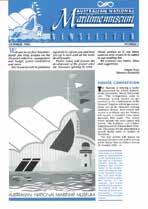
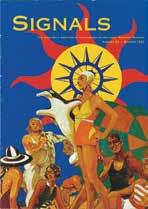
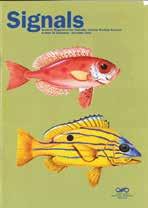

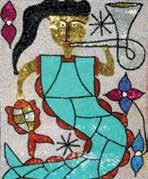




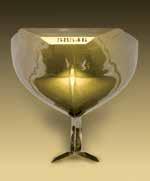
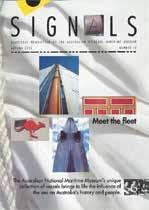

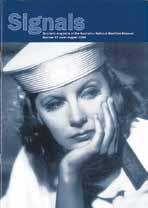
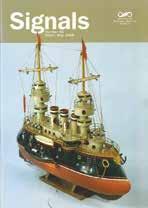






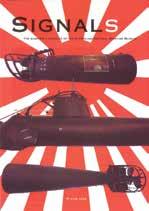


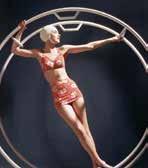

MESSAGE TO MEMBERS
WELCOME TO THE FIRST issue of the Australian National Maritime Museum’s quarterly journal Signals for 2013. We have given our flagship publication a generous new look and size, in keeping with many other exciting changes that are happening around the museum now or in the coming period.
It’s all about making your museum serve you better, with changes to our facilities, our galleries, the programs that we offer, the way we use and interpret the historic vessels at our wharves. With Signals, we wanted to ensure that it’s clear and easy to read, while retaining the depth and variety of illustrated articles that we present to our Members and other readers. Signals is one of the great benefits of being a Member of the Australian National Maritime Museum, and it’s delivered to you first and foremost as part of your membership package.
But did you know that Signals is also read and consulted worldwide? After its publishing period of three months – when you as Members are its primary recipients – each issue is digitised and put online in a searchable form, where it can be accessed by researchers or anyone who is interested in what’s happening in Australian maritime history, and how we ‘do’ maritime heritage at this museum.
Signals online is part of the digital resources of our public research facility the Vaughan Evans Library, which has this country’s largest collection of maritime books and journals. As Members you can visit the library at our Wharf 7 Maritime Heritage Centre whenever you like, by appointment with a simple phone call. But from your own home or networked device you can access any back issue of Signals – going back to its origins in 1986 at the start of the project to build a brand-new national maritime museum for Australia – and seek out any topic using a simple-to-use search engine. It’s at www.anmm.gov.au/signals.
Meanwhile, if you have any comments or suggestions about Signals new look, drop a line to its editor Jeffrey Mellefont or email signals@anmm.gov.au. We would love to hear from our readers, about what you think and what interests you.
I’d like to send a warm hello to all those new Members – and new readers of Signals – who joined up in large numbers over this recent summer. Look out for an invitation to a welcome party for new Members in March, where you can meet the director and other key staff. Greetings also to our existing and renewing Members.
Once again we’ve got plenty planned for the year ahead – exhibitions and events to appeal to all ages and interests. We offer more than 60 enjoyable and stimulating activities each year, ranging from harbour cruises and sailing to talks, tours and walks. We also take advantage of short-notice opportunities for events that we promote via email, and we produce a monthly electronic newsletter – do make sure that we have your email address, so you don’t miss a thing.
Two new exhibitions open this quarter: the enjoyable, interactive Rescue and the stunning Elysium Antarctic Visual Epic Please check our Members’ event listing for preview details and other special activities. For kids’ activities such as Mini Mariners, Kids on Deck and special Family Fun Days (all free for Members!), refer to our handy What’s On brochure that’s included in your mailing of Signals
We had a record number of visitors to the Members’ Lounge over summer, too. It’s open every day from 10 am to 4 pm –don’t forget to pop in during your next visit for complimentary tea, coffee or cold drinks, and a chat with the friendly volunteer hosts and hostesses. If you like mixing with Members and have some time to spare, you might consider becoming a Members lounge volunteer yourself – if interested in helping please give me a call.
We look forward to seeing you at the museum soon.
Diane Osmond, acting Members manager
AUTUMN 2013
Author talk
Flinders: The man who mapped Australia, with Rob Mundle
2–4.30 pm Sunday 3 March
The amazing story of the first man to chart Australia’s coastline
Members regatta
Sydney by Sail 2013
10.30 am–2.30 pm Saturday 9 March
Enjoy some expert tuition, find your sea legs then get ready to race!
Special event
Welcome to new Members
4.30–7 pm Friday 15 March
Meet the director and hear about the year’s planned Members events
Phil Renouf Memorial Lecture
John Young: Wooden boat building … NOT a dying art!
6–8.30 pm Thursday 21 March
Wooden boat building as a catalyst for social transformation
Bookings and enquiries
Booking form on reverse of mailing address sheet. Please note that booking is essential: online at anmm.gov.au/membersevents or phone (02) 9298 3646 (unless otherwise indicated) or email members@anmm.gov.au before sending form with payment. All details are correct at time of publication but subject to change.
Rescue family fun day
Mayday and mayhem!
11 am–3 pm Sunday 7 April
A special day of fun in association with the Rescue exhibition
Conversations in the lounge
Alfred Knight: From the London Blitz to Sydney
3–4 pm Sunday 7 April
Lively reminiscences from one of our long-term volunteers
Film and exhibition preview
Elysium Antarctic Visual Epic
6–8 pm Friday 12 April
A breathtaking look at the world’s last pristine wilderness
Special guest speaker
Captain Mike Taylor Southern Ocean rescue!
6–7.30 pm Tuesday 16 April
A first-hand account of the recent rescue of lone round-the-world yachtsman Alain Delord
On the water
Spectacle Island’s naval heritage
10 am–2 pm Thursday 18 April
This historically significant island now houses RAN heritage items
Special event
Battle of the Coral Sea commemorative lunch
12–3 pm Saturday 4 May
Commemorating this strategic Allied victory of World War 2
Curator talk
Exploring wrecks off Raine Island, Great Barrier Reef
6–9 pm Thursday 9 May
Our latest expedition in search of 19th-century wrecks
Coach trip
Fort Scratchley and Newcastle
Maritime Centre
8.30 am–6 pm Thursday 16 May
A day trip to investigate Newcastle’s maritime history
Family fun day
Excellent Endeavour!
11 am–3 pm Sunday 19 May
Learn seamanship skills and enjoy interactive performances and character tours
RAN Centenary lectures
World War 1 at sea
1.30–4 pm Sunday 19 May
Naval history experts explore the Navy’s roles in World War 1
On the water
Japanese midget submarine sites and Garden Island
10 am–2.30 pm Friday 31 May
A trip to commemorate the 71st anniversary of the Battle of Sydney Harbour
01
02
03 Wave rescue interactive.
Photo courtesy of Scitech, Perth
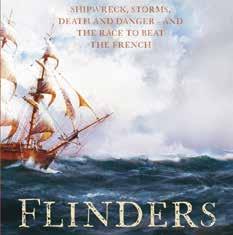

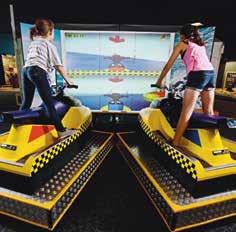
Author talk
Flinders: The man who mapped Australia, with Rob Mundle
2–4.30 pm Sunday 3 March
The amazing story of the extraordinary man who was the first to chart Australia’s coastline. Rob Mundle brings Matthew Flinders’ fascinating story to life from the heroism and drama of shipwreck, imprisonment and long voyages in appalling conditions, to the heartbreak of being separated from his beloved wife for most of their married life. This is a gripping adventure biography brilliantly told!
Members $25. Guests $30. ANZ Theatre. Book signing by the author. Includes Coral Sea wines and refreshments. Booking essential 9298 3646
Members regatta
Sydney By Sail 2013
10.30 am–2.30 pm Saturday 9 March
Learn the elements of sailing in style and practise manoeuvres to get your sea legs, then pit your skills against the competition on magnificent Sydney Harbour, all under the tuition of an experienced and helpful Sydney By Sail skipper. No previous sailing experience required.
Members $60. Guests $75. Includes morning tea and fish and chips in Yots Cafe afterwards
Special event
Welcome to new Members
4-30–7 pm Friday 15 March
Join us for a Members’ welcome for all our new holiday recruits. Meet the director and hear about the exciting family events planned for the season. Enjoy refreshments, meet new friends and catch up with old, while the kids can sample craft activities. Afterwards visit our engaging new exhibition Rescue, from Scitech in Perth, which gives families the chance to experience and react to high-pressure rescue-based scenarios that simulate situations in which people’s lives are at stake.
Free for new Members. Terrace Room. Bookings essential: 9298 3646
Phil Renouf Memorial Lecture
John Young: Wooden boat building … NOT a dying art!
6–8.30 pm Thursday 21 March
The Australian National Maritime Museum and Sydney Heritage Fleet again join forces to present this annual lecture. This year’s speaker is John Young, respected Tasmanian boat builder and historian. ‘At community level, wooden boat building can be a catalyst for social transformation,’ says John. He will be joined by prominent Sydney boat craftsmen Tim Smith and Simon Sidoubin for a question-and-answer session.
ANMM and SHF Members $25. Theatre. Guests $35. Includes refreshments and Coral Sea wines. Bookings essential: 9298 3646
Rescue family fun day
Mayday and mayhem!
11 am–3 pm Sunday April 7
Celebrate everyday heroes in a special family day of fun in association with the Rescue exhibition. Meet our rescue worker guests and hear their stories. Enjoy family films and face painting. Make souvenir badges or life savers and play radio games in Kids on Deck.
Free for Members. See www.anmm.gov. au/kids for more event details
Conversations in the lounge
Alfred Knight: From the London Blitz to Sydney
3–4 pm Sunday 7 April
Join Alfred, ‘rum taster extraordinaire’, for an afternoon of memories and unexpected surprises, complete with souvenirs. Alfred’s tales span the London Blitz, when he was a senior messenger in the National Fire Service at Greenwich, to service in the Royal Navy and his later migration to Australia. Alfred has been a volunteer at the ANMM since 1999 and has helped train other guides. He is a member of the Vampire Association. Stand by for an adventure! Free for Members. Members Lounge. Includes afternoon tea. No bookings required
AUTUMN 2013
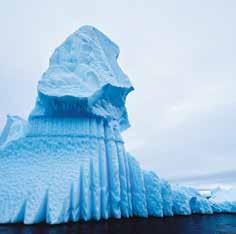

Film and exhibition preview
Elysium Antarctic Visual Epic
6–8 pm Friday 12 April
In February 2010, a team of 57 wildlife photographers, filmmakers and marine scientists embarked on a voyage to Antarctica, from the Weddell Sea to South Georgia. The team captured the splendour of the fauna, terrain, sights and sounds of this enchanting region, using biological samples, photographs and video – all of which will be revealed at this preview.
Members $25. Guests $30. Terrace Room. Includes refreshments and Coral Sea wines. Bookings essential: 9298 3646
On the water: Meet the neighbours Spectacle Island naval heritage
10 am–2 pm Thursday 18 April
Spectacle Island in Sydney Harbour is historically significant as Australia’s oldest manufacturing and storage facility for naval explosives. It now houses RAN heritage items, including relics, artefacts and vessels. After a short cruise from the museum we will take a guided tour of the island then enjoy a picnic lunch on the lawns.
Members $60. Member families $110. Guests $65. Meet next to the HMAS Vampire ticket booth at 9.45 am. Includes morning tea and lunch. Bookings essential: 9298 3646
01 Antarctic iceberg
Photo Michael Aw/ElysiumEpic.org
02 Rum ration vessel, Spectacle Island
Photo J Mellefont/ANMM
03 Archaeology on the Great Barrier Reef
Photo Xanthe Rivett 2009

Curator talk Wrecks on the reef
6–8 pm Thursday 9 May
Join maritime archaeology manager Kieran Hosty for an illustrated talk about our latest expedition, to Raine Island on the Great Barrier Reef, locating and exploring the shipwrecks Morning Star (1814) and Fergusson (1841). The museum’s Great Barrier Reef maritime archaeology program is a collaboration with expedition partner Silentworld.
Members $15. Guests $25. Theatre. Includes refreshments and Coral Sea wines. Bookings essential: 9298 3646
Special guest speaker
Orion’s Captain Mike Taylor
6–7-30 pm Tuesday 16 April
‘You’re hoping for life and for someone to come and rescue you.’ Alain Delord
Join Captain Mike Taylor of Orion Expeditions as he gives us a first-hand illustrated account of the rescue of solo round-the-world sailor, 63-year-old Alain Delord, after his yacht was dismasted in the Southern Ocean 500 nautical miles southeast of Tasmania. Learn of the agencies and challenges involved in effecting these dangerous rescues.
Members $15. Guests $20. Theatre. Includes refreshments and Coral Sea wines. Bookings essential: 9298 3646
Special event
Battle of the Coral Sea commemorative lunch
12–3 pm Saturday 4 May
The Battle of the Coral Sea, fought between 4 and 8 March 1942, was a strategic victory for the allies, turning back the seemingly unstoppable Japanese expansion for the first time. Guest speakers are RAN Fleet Commander and Museum councillor, Rear Admiral Tim Barrett AM CSC RAN and the United States Naval Attaché, Captain Stewart Holbrook USN. $85 per person. Terrace Room.
Seating will be 10 per table. Make up your own table or advise preferences when booking. Bookings essential: 9298 3646
Coach trip
Fort Scratchley and the Newcastle Maritime Centre
8.30 am–6 pm Thursday 16 May
Board our coach for a day trip to Newcastle to visit the Newcastle Maritime Centre and take a tour of historic Fort Scratchley. Built in 1882, this is the only fort in Australia to fire on the enemy during World War 2, when Japanese submarine I-21 attacked Newcastle on 8 June 1942. After lunch at leisure on the waterfront, we will visit the Newcastle Maritime Centre, a waterfront maritime museum.
Members $60. Guests $70. Meet at the ANMM entrance at 8.15 am. Includes morning and afternoon tea. Bring a picnic lunch, or there will be an opportunity to buy food. Bookings essential: 9298 3646
04 Junior maritime architect at work
Photo A Frolows/ANMM
05 Japanese midget sub section, Garden Island
Photo J Mellefont/ANMM
06 Krait, a floating war memorial
Photo J Mellefont/ANMM
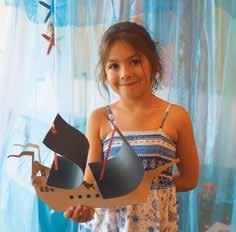


Family fun day
Excellent Endeavour!
11 am–3 pm Sunday 19 May
Uncover the stories behind our HMB Endeavour replica in a day of family fun. Learn seamanship skills, build your own paper tall ship in Kids on Deck or take part in interactive performances and character tours. Enjoy screenings of your favourite Captain Cook documentaries Free for Members. See www.anmm.gov. au/kids for more event details
On the water
Japanese midget sub tour
10 am–2.30 pm Friday 31 May
On the 71st anniversary of the Japanese midget submarine raid on Sydney Harbour, join expert and author Steven Carruthers (seee book review on page 64) and curator Lindsey Shaw in a cruise of the major sites, followed by a visit to Garden Island’s Naval Heritage Centre to see a conning tower recovered from a midget sub. Enjoy lunch on the island before returning to the museum.
Members $65. Guests $75. Children $35 Meet at Vampire ticket booth 9.30 am. Includes morning tea on the boat and lunch at the Salt Horse café at Garden Island. Bookings essential: 9298 3646
In Krait’s wake through the East Indies
25 September–8 October
70 years after Operation Jaywick, celebrate the voyage of WW2 commando raider Krait on a special Expedition Cruise from Darwin to Singapore with the museum’s new travel partner APT. In September 1943 Krait carried 17 Australian and British commandos, disguised as Malay fishermen, through the enemy-occupied East Indies to attack Japanese shipping in Singapore Harbour. The legendary Krait, owned by the Australian War Memorial, is displayed, preserved and operated by the ANMM.
RAN Centenary lectures
World War 1 at sea
1.30–4 pm Sunday 19 May
Marking 100 years of the Royal Australian Navy, we host naval history experts from the Seapower Centre who explore the Navy’s roles in World War 1, including the introduction of naval aviation, submarine warfare, and the vital role of maritime communications. Using the latest research, speakers Dr Norman Friedman, Dr David Stevens, Dr Duncan Redford and Commander David Hobbs will offer new perspectives on Australia’s navy. The lectures will finish with a questionand-answer session with the panel.
Members $25. Guests $30. Theatre. Includes refreshments and Coral Sea wines. Bookings essential 9298 3646
Members’ preview
East of India – Forgotten Trade with Australia
Thursday 6 June
Join ANMM curators for a talk about this new exhibition, which tracks our colonial links with India, the power and monopoly of the English East India Company, and its inevitable decline. It’s a tale of ships and shipwrecks, rice and rum, officers and officials, sailors, soldiers and servants – taking us from the old allure of Asia to modern-day ties between India and Australia.
The luxury 100-passenger MS Caledonian Sky sails from Darwin on a 14-day cruise through the Indonesian archipelago with an expedition team that includes naturalists, an anthropologist, a military historian and a specialist on Indonesian maritime culture and history from this museum. Ten Zodiacs allow passengers to visit remote destinations beyond the scope of larger cruise vessels. As well as following parts of Krait’s route, voyage highlights include Dili, Flores, Rinca (Komodo dragons), Sumbawa (where wooden ships are still made without plans), Bali, Banjarmasin and Kumai in Borneo (orang-utans), Belitung, Sekupang and Singapore.
Museum Members will enjoy a special all-inclusive discount price. For details and prices – and other APT itineraries exploring the waters of Australia and our region – call 1300 514 603 or visit www.aptouring.com.au. See also APT’s advertisement on inside back cover.
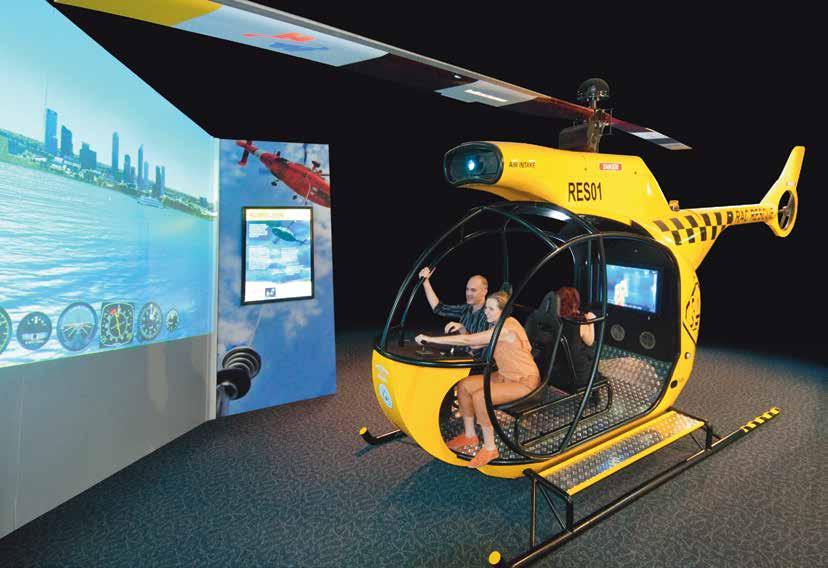
From 16 March
Rescue services are lifelines to countless people in times of need. Rescue puts you in charge as you discover what it’s like to be involved in land, sea and air rescues. Take control of a life-sized helicopter simulator, navigate a jet ski to find a swimmer washed out to sea or experience what it’s like to find your way through a smoke-filled room. Interactive exhibits will teach you about search techniques, rescue supplies and equipment such as the ‘jaws of life’. Visitors can try on various real-life rescue uniforms, including firefighter, surf lifesaver and paramedic. Or, in a sea of blue plastic balls, they can get a feeling for how difficult it is to climb aboard a raft in heaving seas. Crossing a narrow beam over a simulated deep ravine gives an idea of how rescuers have to overcome their own fears to save others.
The exhibition is suitable for children from five to 12 years and their carers, and encourages whole-family interaction and teamwork through interactive exhibits. Primary-aged school students particularly will benefit from interacting with exhibits that involve collaboration and assistance in physical rescue situations. Secondary students will be able to explore more complex rescue concepts through exhibits involving search patterns and wave rescues. There is also a school program tailored to students from eight to 12 years, which challenges them to identify particular examples of rescue technology in the exhibition and find out how they work or what they are used for.
Do you have what it takes to be a hero?
Adults and ages 5–12 years anmm.gov.au/rescue
01 Rescue interactive helicopter exhibit
Photo courtesy of Scitech
02 Seafaring with the nautical Finns
03 King penguin pair
Photo Steve Jones/ElysiumEpic.org
04 The famous Taipan, Wharf 7 foyer
Photo A Frolows/ANMM
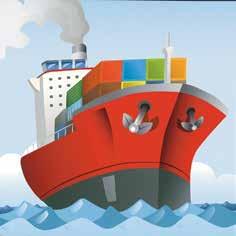
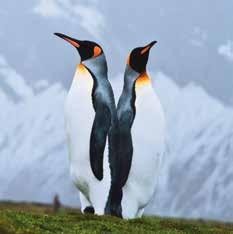

This hands-on exhibition highlights modern seafaring and its industry. Come and ‘operate’ a forklift to pick up containers, steer remote-controlled ships around the museum’s pond, design a ship of the future and rescue someone who’s fallen overboard. Visitors can explore port operations, safety at sea, navigation, seafarers’ stories and marine archaeology.
Visit the hands-on Ahoy AMSA! room – see an overview of the Australian Maritime Safety Authority (AMSA). Navigate your way through a range of kids games based on AMSA’s many activities in environment protection, safe shipping and search and rescue.
Adults and ages 8–12 years www.anmm.gov.au/ships
From 13 April
In 2010 a team of explorers comprising wildlife photographers, filmmakers and scientists embarked on an expedition from the Antarctic Peninsula to South Georgia. This stunning visual record of the expedition captures life above and below the ice, the fauna and flora, glaciers, and the magnificent land and seascapes of this great wilderness.
All ages anmm.gov.au/Elysium

Our replica of Lt James Cook’s immortal ship HM Bark Endeavour is open to the public and school groups for tours, with cabins and living spaces authentically fitted out as they were in 1770. Sydney Heritage Fleet’s magnificent 1874 iron-hulled barque James Craig was recommissioned in 2000 after an award-winning 30-year restoration – one of only four such vessels in the world that are still sailing.
Tour of Endeavour included in Big Ticket. Members FREE. Check opening dates and times on 02 9298 3777 or at www.anmm. gov.au/endeavour. James Craig is open for inspection daily, athough please note that she sails on some Saturdays or Sundays. Check www.shf.org.au for inspection and sailing details
The Wharf 7 Maritime Heritage Centre foyer houses a spectacular display of classic watercraft – all on the Australian Register of Historic Vessels – plus engines and major artefacts, from Sydney Heritage Fleet and the National Maritime Collection. Explore the history of Pyrmont and the nearby industrial harbourscape, placing our modern setting in its historical context. Wharf 7 also houses the collections, libraries, workshops and offices of both ANMM and Sydney Heritage Fleet. See lightship CLS4 Carpentaria and the barque James Craig alongside.
ANMM travelling exhibitions
On their own –Britain’s
Until 28 April Albury LibraryMuseum
From the 1860s until the 1970s, more than 100,000 British children were sent to Australia, Canada and other Commonwealth countries through child migration schemes. The lives of these children changed dramatically and fortunes varied. Some forged new futures; others suffered lonely, brutal childhoods. All experienced dislocation and separation from family and homeland.
A collaboration between the ANMM and National Museums Liverpool, UK
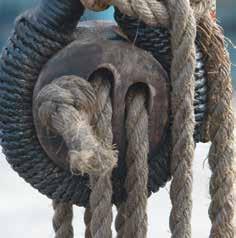
A caravel called Notorious surprises visitors to the Australian Wooden Boat Festival in Hobart, reports Jon Fairall. It’s a 10-year project that grew from one couple’s dream, inspired by local folklore and admiration for the Portuguese vessels that ushered in the Age of Discovery.
SOMETIME THIS YEAR, IF YOU ARE lucky, you may glance out to sea and see a Portuguese-style caravel voyaging up the east coast of Australia, sailed by a couple from Port Fairy, Victoria, called Graeme and Felicite Wylie. If you were in Hobart at this year’s Australian Wooden Boat Festival, you’d have seen her in the parade of sail on the Derwent River and tied up with all the other heritage craft.
A caravel?
Between the 12th and the 17th centuries the caravel was a ship of choice for long, dangerous voyages, at least among the Iberian nations – Portugal and Spain – that led the Age of Discovery. By the standards of the time, they were speedy, manoeuvrable, weatherly ships. But this caravel is the result of a purely local, Australian dreaming. Specifically, she is Graeme Wylie’s dream. Graeme and his wife Felicite designed and built her over a 10-year period in their backyard in Port Fairy, just to the east of Warrnambool, Victoria, using stockpiles of local timber.
In 2000, Graeme was a furniture maker in Port Fairy, a pleasant fishing village at the end of the Great Ocean Road on the long lee shore of western Victoria that’s called The Shipwreck Coast. He was fascinated by the local legend of The Mahogany Ship, which dates back to an 1847 article in the Portland newspaper about the uncovering of a wreck on the beach in Armstrong Bay, just west of Warrnambool, that was made of some exotic, dark timber. A ship hidden beneath the sands has been part of the area’s folklore ever since, along with the notion that it was made of mahogany.
Kenneth McIntyre’s 1977 book The Secret Discovery of Australia associated this legend with his idea that the Portuguese, in South-East Asia and Timor in the early 16th century, sailed on further to discover Australia and could even have been shipwrecked on the Victorian coast. This gave impetus to renewed searches for The Mahogany Ship, none of them successful. Most experts now believe it either never existed or it was the remains of any of a number of more recent ships,
including a whaler and a timber carrier, that have come to grief on this stormy coast.
The Portuguese centuries of discovery are certainly fascinating, and that’s no mystery. In their relatively tiny ships, without anything that a modern mariner might recognise as a chart or navigation instrument, they sailed the world from their south-western corner of Europe, around the Cape of Good Hope to the Malabar Coast of India and on to the Spice Islands – to within just a few days’ passage from the Australian continent. There is no hard evidence that they got here … but then, proponents of the theory argue there is little documentary evidence to support any part of the history of Portuguese discovery. The Portuguese were secretive and protective of their discoveries, and many of their records were lost in the great earthquake and fire of Lisbon in 1755.
As an experienced small-boat sailor and prospective caravel builder, Graeme Wylie was likewise astonished to discover how little we know about the ships they used.
The behaviour of the Portuguese mariners who sailed these ships made them notorious in both Africa and India
MARITIME
AROUND AUSTRALIA WARRNAMBOOL
01 Deadeye and lanyard, the system of tensioning rigging. Photographer Jon Fairall
02 A 15th-century-style Portuguese caravel has never before been seen on the Derwent River off Hobart. This re-creation of a ship from the Age of Discovery was in the parade of vessels for the recent Australian Wooden Boat Festival. Photographer Sam Rosewarne, Hobart Mercury/Newspix

We have not a single surviving ship, not a wreck on the seabed, not a shipyard plan or document, not a notice from one shipwright to another with instructions on how to build one.
We have some idea of what a caravel looked like, because they appear in contemporary paintings and decorate the maps of the times, their billowing sails embroidered with the blood-red cross of Christ – but not to scale, and not as accurate depictions, since these were not the artists’ concern. Some simplified models hang in churches, made as offerings but not as authentic representations. So, instead, Graeme Wylie obtained what information he could from academic sources, taught himself the fundamentals of naval architecture, and began to design a caravel.
‘Portuguese shipwrights would have learnt how to build a ship by watching their teachers. I had to learn from books. Given the variation in design that we know occurred during this period, and the lack of standardised patterns, I think my design is probably as good a caravel as any,’ he says.
The caravel, we presume, evolved from Iberian fishing boats. As Portuguese fishermen became more far-ranging, perhaps around the beginning of the 13th century, their boats became larger, to handle bigger catches and bigger seas. To make them more seaworthy, they were decked, first with a half-deck forward that could provide shelter for the crew, then covering the entire vessel. Over the next three centuries the caravel began to swell as shipwrights experimented with different sail plans, hull dimensions and shapes. The nimble caravel grew in size to become the carrack and then the lumbering galleon, in which the spoils of empire could safely be returned to Europe. But ship building remained an art and a craft, not a science.
There were some revolutionary aspects to the caravel design, compared to the larger craft of northern Europe that were generally still built of clinker (overlapping) planking, with ribs added for strength after the planked hull was formed. The caravel’s framing of curved futtocks making up ribs was built up on the massive keel, before the planks were added. And, importantly, the planks were butted edge-to-edge in the style we call carvel (a term derived from ‘caravel’). This made the hulls stiffer.
We had a four-metre swell running during part of the trip and shipped almost no water on the decks
They also replaced the steering oar with a rudder hung on pintles from a specially designed stern post. This idea seems to have come from the Chinese, by way of the Indian Ocean and the Mediterranean.
Also coming, it seems, from the Arab traditions of the Indian Ocean was the characteristic lateen sail. These modifications made the caravel ideal as a ship of discovery, fast and weatherly. For at least a century – let’s say about 1350–1450 – it was the apogee of marine technology, a vital part of the Portuguese tool kit for their aggressive expansion.
Graeme Wylie has called his caravel Notorious because, he told me, ‘The behaviour of the Portuguese mariners who sailed these ships made them notorious in both Africa and India.’
Graeme’s caravel displaces 58 tonnes, which seems to be about the size of a caravel in 1500, when Vasco da Gama
01 Timbers hewn by hand and adze and coated with a traditional mix of tar, pitch, linseed oil and turpentine provide an authentic finish.
Photographer Jon Fairall
02 The lateen-rigged caravel Notorious on her maiden voyage in 2011, when originally rigged with a small mizzen mast and sail.
Photograph reproduced courtesy of The Standard, Fairfax Media.
03 Owners and builders of Notorious Graeme and Felicite Wylie of Port Fairy.
Photographer Sam Rosewarne, Hobart Mercury/Newspix
used one, the Berrio, to accompany his carracks, the São Gabriel and the São Rafael, on his first voyage to India. Notorious is 18 metres length by 5.5 metres beam, giving a length-to-beam ratio of 3.27. Some evidence suggests that the earliest caravels were narrower. By the 17th century, they were much fatter, reaching 2.6 to 1. Notorious could have about the right length and proportions for a ship of Vasco da Gama’s era.
Early Portuguese caravels were typically built of oak, with some non-structural timbers from cork wood. But by the end of the 14th century, Portugal’s native forests were denuded and replanted with pine. However, the Portuguese had discovered the Isle of Wood – Ilha do Madeira – which they settled from the early 1420s, establishing a major shipbuilding industry founded on Cupressus lusitanica, the Portuguese cypress tree, which covered the island.
Notorious is built from a local equivalent. Her hull timbers are Monterey cypress (Cupressus macrocarpa). Her keel and rudder are iron wood (Eucalyptus sideroxylon), salvaged from the old pier at Warrnambool. Graeme says macrocarpa had a number of advantages. It is strong, easily worked and extremely resistant to salt water. It was also free. ‘In 2000, all the farmers around Warrnambool were busy knocking over their macrocarpa. I just had to cart it away,’ he says. Eventually, he acquired about 300 tonnes of timber, and stored it on his property.
Logs scavenged from a field are one thing; cutting them up into usable planking is another. Graeme attached a saw blade to a motor scavenged from a Datsun 200B motor car. He cut lengths of timber 100 mm thick for the deck and hull planking, as well as the futtocks that became the ship’s ribs. The planking is fixed into

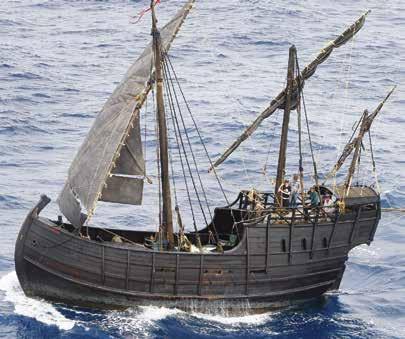
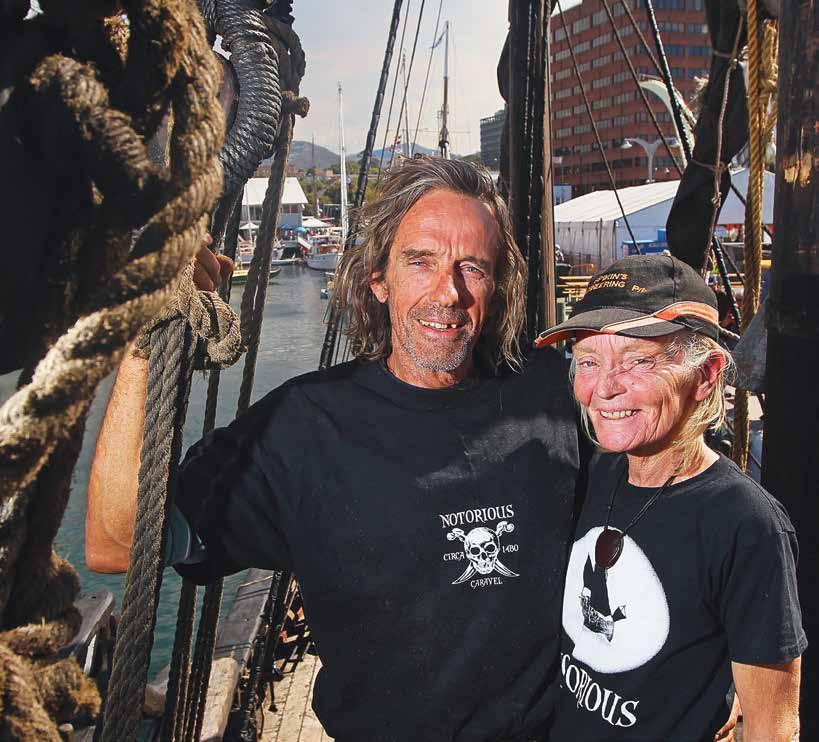
Graeme lifted Notorious onto a low loader and took her down to Port Fairy where she was to be launched


position using wooden pegs called trunnels, or tree nails, as the Portuguese would have done. A few iron bolts are in use, notably to secure major frame members including the keel.
We know that the Portuguese themselves used iron fastening in their ships on the basis of at least one story. By the time Vasco da Gama reached the coast of Africa in 1499, on his way home from India, almost half his men had starved to death, or succumbed to scurvy, and he didn’t have enough healthy people to sail the ships. He decided to leave the São Rafael behind and take the surviving crew on his two remaining ships. But before leaving, he burned the São Rafael in order to recover the iron fastenings from her planking.
During his two-year voyage, da Gama had careened the ships on average every six months, but this wasn’t enough to stop the sea life that was determined to make a good meal of the planking. Indeed, on his way home when he careened the São Gabriel, near the Cape, he found the bottom so eaten through that his carpenters had to cut hundreds of timber plugs from local trees to stop the holes and get them home.
To protect the timbers of Notorious from rot, Graeme used a mix of Stockholm tar, pitch, linseed oil and turpentine, and covered the bottom in modern anti-fouling. Notorious is double planked below the waterline, and tar has been squeezed between the layers. The caulking material is cotton sealed with a mix of ash and tar.
After his 10 years of dedicated labour, in February 2011, Graeme lifted Notorious onto a low loader and took her down to Port Fairy where she was to be launched. Here he bolted the after castle onto the hull, stepped the masts and undertook sea trials off Port Fairy in December of that year, and sailed on his maiden voyage in January 2012.
She is, says Wylie, a comfortable boat at sea, particularly compared to the other small boats on which he has sailed. ‘We had a four-metre swell running during part of the trip and shipped almost no water on the decks,’ he says. He reports that the famous lateen rig really does give the ship the ability to work to windward. It certainly doesn’t point as high as a modern yacht, and it probably makes more leeway when a bit of a sea is running.
The lateen yard is shipped outside the mast’s stays, so it is almost impossible to tack in the usual manner, by bringing the ship’s head through the wind. To get onto the opposite tack, he says, the easiest thing to do is to wear ship. As the wind shifts aft, the yard can be twisted around the top of the mast. Without a doubt the iron sail, a 170 hp General Motors diesel, is a comfort at times during the process. You don’t want to be sailing among busy Bass Strait shipping lanes unsafely, so it’s not the only modern aid: there is electric lighting below (all tastefully hidden) and navigation lights above, a GPS and radios. Even a compass binnacle counts as an anachronism.
01 Ship components carried from the Wylies’ property to her launching place at Port Fairy. Transport was provided by project supporter Ian Spikin, of Spikin’s Engineering, Warrnambool. Courtesy Graeme Wylie 02 Notorious moored at Lakes Entrance after her maiden voyages. Photographer Jon Fairall
The magnetic compass was developed by the Chinese, initially on land. They took it to sea somewhere between the 9th and 11th centuries. Its transmission to Europe is sometimes credited as being via Arab seafarers. There are European references to it in the 13th and 14th centuries, but it does not seem to have been used regularly until later. It seems that those tentative Portuguese steps of exploration down the coast of Africa that were made in caravels occurred without it.
When I caught up with Graeme Wylie and Notorious he was moored in Paynesville in the Gippsland Lakes. His plan at the time was to sail the ship down to Tasmania for the Australian Wooden Boat Festival in February, which at the time of going to press is exactly where he was. He then plans to sail up the east coast of Australia and exhibit the ship at ports along the way. The Australian National Maritime Museum just may be one.
Guest writer John Fairall is a journalist and book author. He is currently writing a book on the Portuguese empire.







ANMM.GOV.AU/ARHV This online, national heritage project devised and coordinated by the Australian National Maritime Museum reaches across Australia to collate data about the nation’s existing historic vessels, their designers, builders and their stories.
Three flood boats represent local solutions to the challenges of this country of ‘droughts and flooding rains’. They were among the 18 craft approved for listing on the Australian Register of Historic Vessels when its council met during early December 2012, writes its curator David Payne.
DIFFICULT WEATHER PATTERNS HAVE always confronted Australians throughout the continent, and once again this year’s summer rains have brought the flooding that is a common though unpredictable part of the way of life in river communities. The dislocation and danger that come with a flooded river were countered by pioneering and settler communities with the introduction of flood boats that served to keep transport routes open, supply isolated communities and homesteads, and even save lives when required. The differing nature of the areas in which they were used has led to quite different types of craft, and the three community vessels that recently entered the Australian Register of Historic Vessels show two quite distinct approaches to their form and construction.
Shoalhaven, from Nowra in the Shoalhaven district on the south coast of NSW, is a fairly conventional timber craft built in 1889 by John Hawken. Its construction, and that of a sister ship Noah, was sponsored by the well-known district landowner David Berry as a gesture of commitment and support for the community. These two 7.31-metrelong (23 foot 8 inch) craft were built on Berry’s Coolangatta Estate. They were cedar planked, of clinker construction. Their double-ended hull form somewhat followed the lines of a traditional whale boat, but with a stern post that was relatively straight with little rake. The keel was also straight, with no rocker or camber in profile. They originally came with purpose-built wooden trolleys so they could be pulled by draught horse to the water’s edge for
May Belle was lost in a flood around 1911; her upturned hull was rediscovered by accident in 1973, downstream from the abandoned goldmining town’s ruins –in a dried-up riverbed, covered in bushes
01 May-Belle, a riveted-iron flood boat and ferry from the gold-rush era of the late 1800s, is now housed in the James Cook Museum in Cooktown. Photographer D Payne/ANMM
02 Documenting May-Belle’s unique structure has been supported by one of our annual MMAPSS heritage grants.
launching, and both craft were housed in separate sheds at locations on either side of the district’s Shoalhaven river.
We have not yet uncovered any specific reports of Shoalhaven’s use in times of flood. In 1942, during wartime, it was noted to be in good condition, with the comment that it would be destroyed in the event of an enemy invasion! In 1946 Shoalhaven was used to help sink piles for the Numba swimming baths, then no more is heard until the mid-1960s when a display of historic and antique items was put on in Nowra by the Rotary Club and Country Women’s Association at the Nowra School of Arts. Shoalhaven was included, having been rediscovered locked away in its shed. After this it went through a restoration before going on display in a riverside park at Nowra in the shelter of a small, opensided display pavilion through the 1970s, 80s and 90s. However it suffered from vandalism and was taken away; currently Shoalhaven remains stored away from public view.
May-Belle and its sister ship, the Coen flood boat (pictured on the next page, image number 18), both come from far north Queensland and were built in the mid-1890s to service the goldfields that had opened up in the Cape York district in the 1870s. They have a much different story to tell.
May-Belle was located on the Palmer River at Maytown, in rugged country inland from Cooktown, while the Coen boat operated across the even more remote Archer River further north. For much of the year the land was extremely dry and hot, but in the wet season, over summer, heavy rains caused the dry riverbeds to fill and rise dramatically, and this combination of extreme conditions and location may be the reason for their unusual choice of a metal hull for their construction.





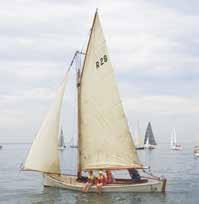





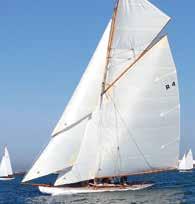
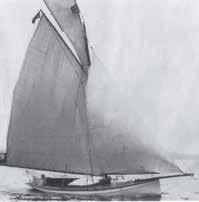






Both are 4.67 metres (15 feet 4 inches) in length and both have the same conventional dinghy or waterman’s skiff style and proportions, giving them a nicely sheered hull profile, rounded stem and raked transom plate. There is a hollow toward the keel in the bottom sections aft that forms a keel toward the transom, providing for steering control. Both have been built from thin-gauge iron plating riveted together on frames of angle bar and flat bar. Construction was most likely by builders Sutton and Gay in Brisbane, to the order of the regional authorities. This choice of a heavy material is unconventional for vessels of this size, since iron or steel is usually best suited to larger craft.
However, this metal construction better suited the hot, dry climate that predominated for much of each year in this inland environment, since the craft would have remained stored out of the water for long periods. This situation would have been unsuitable for a wooden craft, the seams of which would have opened up while out of the water. The boats would not have been usable immediately when required, since the seams of wooden craft take some days to swell and close up again.
It is also possible that the extreme heat and dryness could have caused timber planks to split, rendering the craft unusable when they were most needed.
The metal hulls were also more resistant to damage; the many dimples, dents and deformed areas on the surviving hulls show how the construction could absorb considerable damage but remain intact, even though the surface became somewhat misshapen. A metal hull could also be more easily repaired in inland areas where shipwrights may have been scarce.
The skills and materials required were those of the blacksmith’s trade, an occupation common throughout inland locations. With a likely service life measured in years or decades, any corrosion that led to holes in the hull could be plated over if needed. Thus the choice of a metal-plated hull appears quite appropriate for these inland and mostly dry locations.
As with the Shoalhaven flood boat, reports of their use are scarce. The Coen boat ended up being used by a Chinese market gardener to cross a lake to his vegetable patch, and has finally come to rest at Coen on display at the Cape York Heritage House with other
mining artefacts. It is not currently in very good condition with extensive holes in its bilge plates.
May-Belle is even luckier to have been secured. It was lost in a flood, perhaps around 1911, and later the settlement of Maytown was itself abandoned in the 1940s. May-Belle ’s upturned hull was rediscovered by accident in 1973, downstream from Maytown’s ruins in the dried-up riverbed, covered in bushes. Local council administrator Darcy Gallop recognised its significance and ensured that this important little vessel was recovered. This iron flood boat and ferry from the gold-rush era of the late 1800s has been preserved and housed in the James Cook Museum in Cooktown where it is expertly managed by Dr Melanie Piddocke. The museum this year received one of the Australian National Maritime Museum’s annual heritage grants, to take the vessel’s lines and develop a conservation management plan for it – see the article on pages 30–35 of this issue of Signals for a report on our Maritime Museums of Australia Project Support Scheme.

01 Crew of the YWCA four outside Gardner’s Boatshed, Leichhardt, Sydney. Trixie Forest appears back row, left.
02 YWCA Ladies Rowing Club badge in navy blue with the club’s pale blue triangle logo overlaid.
A collection of rowing memorabilia captures the jubilation of young women whose sporting careers were once nurtured by the ‘Y’ – the Young Women’s Christian Association. Curatorial assistant Penny Hyde traces the material’s route from a deceased estate to the National Maritime Collection.
A is for the appetite which while training we must forgo
B is for the best and best in which we all aspire to row
C is for the coxswains, also coach, who do their work so well
D is for the dozens for which we hear them yell …
SO BEGINS T HE YOUNG WOMEN’S Christian Association rowers’ alphabet, which appeared in the association’s newsletter ‘The Doorway’ in February 1931. In the inter-war years of the late 1920s and early 1930s, the aquatic sport of women’s rowing in New South Wales was able to flourish through the crucial financial and motivational support that was provided by clubs such as the YWCA.
The original YWCA had formed in Britain in 1855 to provide safe accommodation and a network of support for women in London. The Sydney branch opened 25 years later, in 1880, and was the first permanent YWCA in Australia, operating initially out of Loma House in Wynyard Square. The Sydney association mainly provided assistance to women who had migrated to this country, helping them find accommodation and employment. This most vulnerable group was particularly open to exploitation, and the work of the YWCA was vital to the safe, successful settlement of many of them.
As the association grew it was able to widen its services from basic though vital support such as assistance with food and shelter, to the areas of vocational training, physical health and leisure. The association aimed to promote the social, mental, spiritual and physical development of womankind, and for the Australian branch of the YWCA, sport became a crucial element of this mission.
E is for easy oar, we’re glad of that well-known cry
F means we’re feeling fit, and we mean to do or die
G is for the grunts and groans, which instead could stand for grin
H is for the helping hands, who hurry to get a wet boat in …
In the early 1900s the Sydney branch of the YWCA offered women the opportunity to join a variety of clubs under its organisational umbrella. New accommodation in the centre of the city was opened in Castlereagh Street in 1903, supporting these leisure activities with a gymnasium and instructor, a library and reading room, and a club room. The offerings of the clubs included sewing, cooking and other indoor activities, along with a flourishing selection of sporting groups that competed under the YWCA’s blue-triangle symbol in local carnivals.

The world secretary of the YWCA proclaimed proudly that she knew of no other place where it had such a large and popular sporting program
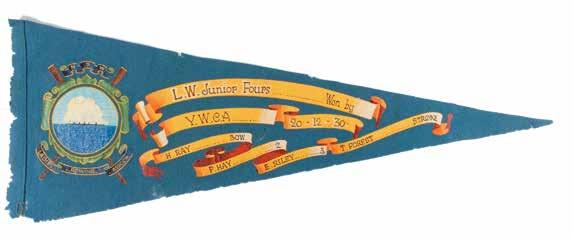
M is for the many things we must give up while training
N is for the never-say-dies who row if it’s windy or raining
O is for the opportunity to row in an interstate crew
P is for patience which we cultivate when we have that end in view …
Hockey, cricket and basketball were offered alongside aquatic sports, such as swimming and rowing.
I is for the independent rowers, who think there’s nothing to learn
J is for the jolly sports who are ready to do a good turn
K is for the kind feeling we show to each new-comer
L means you’re lax in paying your dues, then earn the name of ‘hummer’ …
In 1933 the world secretary of the YWCA, a ‘Miss Niven’, visited Australian shores and proclaimed proudly that she knew of no other place, with the exception of New Zealand, where the YWCA had such a large and popular sporting program.
It was through this program that women’s sports requiring expensive equipment and specialised playing fields or venues and facilities, such as cricket and rowing, were able to develop formal organisations and competitions during the inter-war years. With its strong financial and administrative backing, the YWCA rowing club was part of the initial group of clubs that came together to form the NSW Ladies Rowing Association in 1929. Regular fundraising events such as dances and movie nights were organised to keep the girls in training, to keep the regular regattas operating and to keep the sport growing.
The YWCA rowing girls were based out of Gardner’s Boatshed in Church Street, Leichhardt, and their course was the Iron Cove stretch of river near Drummoyne. They trained often and hard, and their dedicated work was rewarded by the number of titles won and the number of women who were chosen to represent their state in interstate carnivals. In June 1930 Miss Thelma Riley was selected to represent the ‘Y’ in the winning New South Wales crew for the Australian championship in Adelaide. Thelma and her sister Esme both had successful rowing careers as interstate representatives for the YWCA throughout the 1930s.
Q is for the question: Does quarrelling exist among girls who row?
R means the ready answer in the neg, in other words, we mean No!
S means go slow, down you slide, remember you never rush
T means we’re told off for talking –we don’t know the meaning of hush …
In 2007 the Australian National Maritime Museum was offered a collection of rowing memorabilia relating to YWCA rower Trixie Whaling (née Forest). Trixie had been an accomplished cyclist and tennis player who rowed as stroke of the YWCA No 1 Lightweight Junior Championship Four in 1930. In 1931 she took number two oar in the YWCA No 1 Lightweight Senior Fours, and participated in the YWCA’s 4th Annual Regatta in 1932. She was also honorary treasurer of the YWCA rowing club in 1932 and 1933. After her death in 2003, the executors of her estate donated a large collection of material, including the rowing memorabilia, to the Powerhouse Museum. Among her possessions were a number of items that related to her work as a furrier after World War 2; they included rare animal pelts, coats and clothing patterns.
The Powerhouse Museum saw significance for their own collection in the items related to clothing production in Sydney in the 1940s. Its curators recognised, however, that the sporting memorabilia would be best suited to the Australian National Maritime Museum, and so the items were transferred. The rowing memorabilia is an important part of our collection and provides an intimate view into Trixie’s YWCA rowing team, which included Thelma and Esme Riley. The girls’ smiles beam forth from photos; their camaraderie, training and their successes are all captured in a series of professional press images, many of which appeared in contemporary newspaper articles. Most of the photographs were taken in and around the YWCA boatshed in Leichhardt, but there is also a series of the girls sailing as a team on another champion of the day – the 18-foot skiff H C Press, during the annual ‘Ladies Day’ that introduced female crews to this normally very blokey Sydney Harbour sport. Other items include winning pennants and ribbons and an album bursting with newspaper cuttings. Trixie’s photo album is on display in the museum’s core exhibition Watermarks: Adventure, Sport, Play
U for the unity feeling; no club should be without it
V for the vim and vigour we have; look us over, can you doubt it?
W is the weight: are you a heavy or light?
X for the ’xercises we do, p’haps morning and night …
The YWCA sporting programs placed great emphasis on developing a young woman’s health and fitness and although the teams were competitive and successful, building friendships and a sense of fun were also at the heart of the YWCA’s sporting endeavours. This is evident as much in Trixie’s collection as it is in the jubilant lines of the YWCA rower’s alphabet.
Y for the Y feeling we try to maintain, that’s to smile, lose or win
Z means we’ve zealously read the above; in our think-box we’ll lock it all in!
01 New South Wales Ladies Rowing Association Lightweight Junior Fours pennant presented to the YWCA for a race won on 20 December 1930. Trixie was the stroke.
02 YWCA women’s coxed four at practice on Sydney Harbour.

Trixie had been an accomplished cyclist and tennis player who rowed as stroke of the YWCA No 1 Lightweight Junior Championship Four in 1930

In one of history’s great migrations, over six million people have crossed the seas to settle in Australia. The museum’s tribute to all of them, The Welcome Wall, encourages people to recall and record their stories of coming to live in Australia
Building a new life in a new land was the goal of many convicts once they gained their freedom. Welcome Wall historian Veronica Kooyman follows the story of 19th-century convict Elijah Silkman across many lands, from North Africa, Europe and England to his eventual home in the colony of New South Wales.
ELIJAH (ELEAZAR) SILKMAN WAS BORN in about 1804 in Algiers, a city of the Barbary states of North Africa and a colourful, bustling port known in the West for its pirates and slave traders. Although a Muslim city, for hundreds of years Algiers had sustained a thriving Jewish community, which excelled as merchants and traders. The Jewish population substantially increased after 1492 when the Tribunal of the Holy Office of the Inquisition, established in Spain by the Catholic monarchs Ferdinand and Isabella, forced Jews and Muslims to convert or flee. By 1830 the French had conquered the region and created the modern borders of Algeria. It was perhaps this that led Elijah to leave Algiers. It seems he was a shopkeeper in Madrid for a time before making his way to London, where he married in 1832. In 1837 he was arrested for receiving stolen goods and tried at the Old Bailey on 23 October.
The loot he was accused of receiving was significant – 22 necklaces, 11 razors, 159 brooches, 109 seals, 150 breast pins, five pairs of bracelets, 60 pairs of earrings, 17 watch keys, 14 rings, 71 snaps, one pair
of scissors, 20 thimbles and a jewel case, valued at the then-substantial sum of £30–40. A policeman had found the goods stashed in a chest of drawers and a hawker’s box in Silkman’s lodging house. He was accused of inducing a young Jewish errand boy, Manly Abrahams, to steal them from his employers, the brothers John and Alfred Davis, who were importers and wholesale dealers in hardware. Silkman was found guilty and sentenced to 14 years’ transportation. He was very lucky to have escaped hanging in those harsh times, but his sentence meant that he had to leave behind a wife and three children. He was held on board a prison hulk on the River Thames at Chatham in Kent until a transport ship was ready.
On 24 March 1838, the Bengal Merchant departed Sheerness, Kent, bound for the colony at Port Jackson, carrying six female emigrants, nine children, 29 guards, two lieutenants and 271 convicts. The ship was under the command of Captain William Campbell, with Surgeon Superintendent Isaac Noott caring for the health and welfare of all on board. The prison area was kept as dry and clean as possible and several
times a day the prisoners were taken on deck in large groups to walk about and exercise. Nevertheless, on 20 May there was a severe outbreak of typhus that affected the prisoners, crew and soldiers. Three people died during the voyage and two children succumbed after reaching Australia.
In 1838 the colonists in New South Wales were anxiously awaiting the arrival of the convicts, whose labour was badly wanted. One anonymous letter published in The Sydney Gazette and New South Wales Advertiser, dated 28 July 1838, wrote of the great need:
The Bengal Merchant – the first of this season’s convict ships – has brought the first supply of convict labour since Governor Gipp’s arrival on these shores – giving His Excellency an opportunity to alter the lately adopted system of assignment to private service, and to give each just claimant a proportionate share of the men now in harbour.
Much anxiety is felt by flock-owners and agriculturists, as to the distribution of these convicts ... Now, when labour is so scarce, that in many cases the plough is left idle
01 Advertising passages on the ship that brought Elijah Silkman to Australia. Image © CSG CIC Glasgow Museums Collection
02 Betty Palmer (née Silkman) and Marcia Meyjes (née Silkman) at the November 2012 unveiling of new names on the Welcome Wall. Photographs on these pages courtesy of Ray Palmer and John Hensford
03 Annie Silkman (1860–1949) who married to become Mrs Grodner.
04 Fanny Silkman (1863–1932) who married to become Mrs Michael).

[and] two flocks placed in one – lambings neglected – and our shearing season and harvesting at hand, the arrival of laborers is hailed with pleasure. Indeed arrivals, both emigrant and convict, are, like genial showers, long away – long wished for, and have at length arrived, just in time to save the half perished crops.
The convicts on board were distributed to various regions, including the Hunter Valley. Elijah was sent to Goulburn, a new settlement that could scarcely yet be called a town. He was assigned to a local barber and worked for him in this trade, continuing the business after his master died. On 18 July 1845, seven years after his arrival in New South Wales and only halfway through his original sentence, Elijah was granted a ticket of leave on condition that he remain in the Goulburn district. On 24 December 1849 he was granted a pardon and on 12 October 1853 he became a naturalised British subject.
In 1854, his wife in England died. Four years later he married a free settler, Sophia Collins, at the York Street Synagogue in Sydney. Sophia, 26 years his junior, came from a respectable family in England. It is thought the marriage was arranged, which in turn suggests that Elijah had developed a good reputation in his new homeland. Their first child was born in Goulburn, which by then had a significant and highly
regarded Jewish community. However, the lure of much larger settlements, such as Sydney, proved too strong for some of those living in the inland agrarian town. Around 1859, Elijah like many others relocated to Sydney, setting himself up in business as a barber and draper. His new start was financed by the Goulburn Hebrew Association. The couple’s other four children were all born in Sydney. Though Elijah’s business failed, one of his sons, Jacob, learnt the family skills and also became a barber.
Elijah died in 1878, and Sophia in 1900. In Australia Elijah lived an honest life, one inconsistent with the rogue or ‘Fagin’ character portrayed in the original court transcripts. Though Elijah and Sophia never returned to Goulburn, their descendants continued the family’s association with the oldest inland city in Australia. One of Elijah’s grandchildren was an express locomotive driver stationed in Goulburn during World War 2, whose own family worked in the local businesses. More recently, two of Elijah’s great-great-granddaughters and one great-granddaughter moved to Goulburn, at the time unaware of their ancestral connection to the city. In November 2012 the names of Elijah and Sophia Silkman were unveiled on the Welcome Wall, along with those of other family members. The event provided an opportunity for a family reunion, with 40 relations attending.
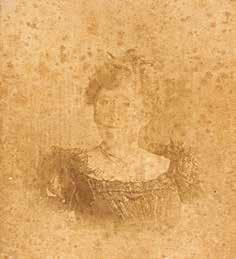
Silkman was found guilty and sentenced to 14 years’ transportation. He was very lucky to have escaped hanging in those harsh times, but his sentence meant that he had to leave behind a wife and three children
The Welcome Wall
It costs just $105 to register a name and honour your family’s arrival in this great country! We’d love to add your family’s name to The Welcome Wall, cast in bronze, and place your story on the online database at www.anmm.gov.au/ww. So please don’t hesitate to call our staff during business hours with any enquiries on 02 9298 3777.



Saltwater people of the broken bays
Sydney’s northern beaches
By John Ogden, published by Cyclops Press, Avalon, NSW, 2011. Hardcover, illustrations, 316 pp, ISBN 9780980561913. RRP $99.00
Saltwater people of the fatal shore
Sydney’s southern beaches
By John Ogden, published by Cyclops Press, Avalon, NSW, 2012. Hardcover, illustrations, 336 pp, ISBN 9780980561920. RRP $99.00
THE BEACH HAS BEEN WRITTEN ABOUT by innumerable authors, academic or otherwise. It has been the focus of histories of the shaping of Australian identity, as swimming and surfing came to figure so prominently in the European–Australian psyche. An influential historian, the late Greg Dening, analyses it as a place of encounter, exchange and invasion. However, the coast – that broader littoral zone between the maritime and dry land – has not been treated by historians in such a manner, and deserves further interrogation.
The beaches and coastline that fringe Sydney’s north and south are the subject of two recent companion books by John Ogden. Saltwater people of the broken bays – Sydney’s northern beaches explores the history and coastal scenery between Sydney Harbour’s North Head and Barrenjoey, the headland on the southern entrance to Broken Bay, just over 40 kilometres north of the Sydney CBD. This is an area that Ogden describes as ‘the birthplace of Australian beach culture’. Saltwater people of the fatal shore – Sydney’s southern beaches makes its journey from South Head to the southern end of the Royal National Park. Ogden notes that this section of coastline, of around 60 kilometres, encompasses what the European colonisers called ‘the birthplace of modern Australia’.
In both of these volumes Ogden searches for the threads of social and political history that seem to gather along these coasts, and overall, it is a wonderful and visceral journey, made by assembling a somewhat eclectic collection of stories, essays, snapshots, historical images and modern photography. Among them are some surprising gems.
I find it intriguing that these two books focus on ostensibly quite different ‘birthplaces’. The notion of the ‘birthplace of modern Australia’ has been acknowledged as dismissive of the people who lived there long before 1770. Ogden well notes this and his focus, in the southern beaches book in particular, is very much on the first peoples of the area. He brings out some important Indigenous histories and has collaborated with Aboriginal people in writing the books.
It’s a wonderful and visceral journey, a somewhat eclectic collection of stories, essays, snapshots, historical images and modern photography
The birth and history of surfing are prominent themes in the first of the two books, on the northern beaches. However Ogden’s second volume is more textured and substantial and offers more social history, such as sections on the Wanda Beach murders, the Bra Boys, the novel and film Puberty Blues and the Cronulla riots. While an ‘Australian beach culture’ is indeed a central feature of Australian cultural identity, and Ogden skilfully brings to light some of its less-well-known historical moments, he misses an opportunity to discuss its role in the creation of an Australian urban masculinity. What emerges is an often-nostalgic picture of beach subcultures.
These handsome books combine exquisite contemporary photography and wonderful archival images. Both begin with overviews of the Sydney Aboriginal people who lived for thousands of years on these foreshores, and then we are taken to a section he calls the ‘first boat people’, encompassing the arrival of Europeans. This is followed by a sweeping tour of all the beaches and bays along the various coasts – from Manly and

Queenscliff to Freshwater and Curl Curl, from Dee Why and Long Reef through to Narrabeen and Newport, Avalon and up to Palm Beach. In the southern volume we tour from South Head, Bondi and all the beaches to Botany Bay, on to Cronulla and then the beaches of the Royal National Park. As Ogden notes, ‘Manly Beach and neighbouring Freshwater are where beach bathing, surf lifesaving and board-riding all began in this country’. Our tour of these northern beaches is followed by a section ‘Bohemians and blue bloods’, which gives an overview of the writers, artists and photographers whom Ogden notes ‘seem to sit at odds’ with the ‘blueribbon conservative politics of the northern beaches’. The connection Ogden makes is that the ‘beach is a great social leveller’ and that ‘a strong link has existed between creativity and immersion in the ocean’.
This thesis may come as no surprise considering Ogden’s pedigree. His ‘addiction to board riding’ began when his father built an 18-foot plywood surfboard in the Adelaide summer of 1961. From age 16
01 Storm swell at Ben Buckler, Bondi Beach. Photographer Bob Barker, Newspix 02 Surfer Perth Standick subsumed by a wave. Photographer Bill Morris

Ogden went on surfing safaris that took him along the Great Ocean Road and to the many legendary surfing breaks of Victoria and New South Wales. During the 1970s he worked as a photo-journalist in South-east Asia and then as the Western Australian correspondent for Tracks surfing magazine, as well as making surfing films. Ogden has since based himself on Sydney’s northernbeaches peninsula and the first of the two volumes is very much tinged with a personal odyssey. Yet it is also an exploration as Ogden searches for those social and political threads that entwine these coasts, and overall, it is an inspiring journey.
The two books are important additions to surfing history and popular histories of place. They not only contextualise the surprisingly long histories of surf culture but explore the sites that generated them. More than this, however, Ogden suggests that beaches can be sites of healing and renewal between Indigenous and other Australians. He hopes that Saltwater people will raise awareness about the need to preserve threatened Sydney rock art,
and he champions the construction of a permanent site on the northern beaches acknowledging Australia’s first people.
Ogden endeavours to show that the beach and the ocean transcend Indigenous and European Australian cultures – that we are all ‘Saltwater people’. However ‘Saltwater people’ is an Indigenous term of identity and place and Ogden risks appropriating this in his efforts towards reconciliation. The addition of a more nuanced study of how Australian beach culture was formed as one of the fruits of colonisation may have assisted here.
Nonetheless the Saltwater series, part history, part coffee-table presentation, is far from a rote chronological history of place, and is well worth spending time with. These weighty and quite lavish hardcover volumes aren’t inexpensive, and some Sydney readers might feel inclined just to acquire the volume that’s closest to home or their preferred beach haunts. I’d recommend, on the contrary, that southern folk read the northern volume, and vice versa!
Dr Stephen Gapps, curator



WORLD WAR 2 CAME TO SYDNEY ON the night of 31 May 1942 with the attack on shipping in Sydney Harbour by three Japanese midget submarines. It’s been well documented in books and in displays at this museum – one featured an entire submarine! Less well-examined is the subsequent shelling of Sydney’s eastern suburbs and the port of Newcastle by a Japanese submarine in the early hours of 8 June. In this new book Terry Jones and Steven Carruthers review the evidence, interview witnesses and scour every military and civil record, media account, museum and archive collection and anecdote they could lay their hands on, to compile this blow-by-blow description of that startling and shocking night when many Sydneysiders thought Australia was about to be invaded.
Terry Jones and Steven Carruthers, published by Casper Publications Narrabeen NSW 2013. Paperback, illustrations, 319 pp. ISBN 9780977506347 (pbk). RRP $34.00
This book was launched here at the museum in January by the Member for Wentworth, the Hon Malcolm Turnbull, in whose electorate many of the shells fell. It was written to correct inaccuracies and the urban myths that surrounded the shellings and their aftermath, and to point out the vagaries of human memory. But it highlights a time when the Australian east coast was truly part of World War 2, when Japanese submarines attacked 41 ships, sank or damaged 21, and 670 merchant mariner lives were lost. German mines and torpedoes accounted for another five vessels and 18 lives.
Ashore, the industrial and naval hubs of Newcastle, Sydney and Port Kembla were obvious targets, and in 1942 Australia was readying itself against attack with coastal artillery, gun batteries, underground bunkers, wardens and control rooms set up. But when the shells started whizzing over Sydney’s eastern suburbs, first thoughts turned to an attack by Japanese aircraft – for those who didn’t just turn over and go back to sleep, assuming it was a false alarm or a practice!
Sydney was hit by 10 shells, only three of which exploded; Newcastle by some 21. Very luckily no-one was killed and injuries were minor and few. This book takes us minute by minute through the attack – what fell where, who saw it, who reported it,
what actions were undertaken. This aspect of the book can be a bit dry ... but not always. ‘Teacups danced in the cupboards,’ write the authors, who also bring us the personal stories of those involved. That includes all those little boys who just HAD to go and see the shelled areas or collect a souvenir, and were invariably told by the authorities to buzz off!
Reports that were subsequently taken as fact are examined and either proven or refuted. Urban myths about a mass exodus from the eastern suburbs and collapsing property prices are not borne out when closely examined, although some people did leave or send their children to the Blue Mountains or beyond. My favourite story is of the nineyear-old from Bondi sent to Cobar at the beginning of the war. He had just returned to Sydney in May 1942, only to be sent back again after the shelling. ‘I’ve never forgiven the Japanese for sending me back to that barren dust bowl,’ he recounts.
Juxtaposed with the Australian stories is the Japanese perspective. Their submarine force had three main duties – sink enemy warships, disrupt and destroy enemy commerce, and undertake shore bombardments where practicable. ‘Like the submarine attacks along the west coast of North America, the main impact of the shellings was psychological, creating fear of an impending Japanese invasion.’
The subject is treated in a logical and detailed way with photographs, maps and plans to support the authors’ conclusions. If you disagree with them or are interested in looking deeper, the sources are all there for you. Or you can enjoy this book for its interesting and well-researched account of a truly scary and unsettling period that is still within living memory. Even better, take the book with you on a tour of Sydney’s eastern suburbs or the port of Newcastle and relive the events that shook those cities. If you play at the Royal Sydney Golf Club then you should definitely read this book – there may very well still be an unexploded shell on the course!
Lindsey Shaw, senior curator

Marine Climate Change: Impacts and Adaptation Responses Report Card Australia 2012
National Climate Change Adaptation Research Facility, CSIRO, Australian Government Fisheries Research & Development Corporation www.oceanclimatechange.org.au
THIS LAST SUMMER WE HAVE SEEN bushfires and high temperature records broken while a new word seems to have added to the Australian weather lexicon – tornadoes. Extreme weather events are related to climate change. While we experience the effects of bushfires, storms and floods, one of the most significant and highest-impact drivers of climate change is less tangible for most of us – Australia’s vast oceanic zones.
Ocean temperatures around Australia have warmed by what might appear a small amount – 0.68ºC since 1910. However the rate of temperature rise in each decade shows an acceleration in Australian waters since the mid-20th century, from 0.08ºC a decade prior to 1950 to 0.11ºC per decade from 1950 to 2011. And scientists identified a ‘marine heat wave’ in early 2011 where sea temperatures along most of the Western Australian coast were 2–4°C warmer than usual. They are now not only predicting future temperature changes, but have increasing amounts of information on the effects of these changes.
In 2009 a collaborative project of scientists and organisations concerned with the marine environment released a ‘report card’ that summarised current scientific knowledge of marine climate impacts for Australia. This was followed by the 2012 report card – the subject of this review –which documented many new changes since 2009. Ninety-eight of Australia’s leading marine scientists contributed.
Short summaries of the report cards are available online. Each section contains information on what is already happening, what may happen in the future, and what actions are under way to prepare and adapt to changes. The reports were produced by a team from 34 universities and organisations, a project team from the CSIRO Climate Adaptation Flagship, and a steering group comprising representatives from the partner organisations NCCARF Marine Biodiversity and Resources Adaptation Network, CSIRO Climate Adaptation Flagship and the Fisheries Research and Development Corporation (FRDC).
The 2012 report card demonstrates that climate change is having significant impacts on Australia’s oceans and marine ecosystems. There is now striking evidence of extensive southward movements of tropical fish and plankton species in southeast Australia, declines in abundance of temperate species, and the first signs of the effect of ocean acidification on marine species with shells. Importantly, with marine environments, what happens in one area can have devastating effects in another. The south-east of Australia has been identified as a global warming hotspot. The warm East Australia Current is extending southward, leading to fast warming. Seaweeds, phytoplankton, zooplankton, and various fishes have been found in areas much further south than they usually inhabit, while rock lobster populations have declined.
The 2012 report card highlights how widely and closely the Australian science community is engaged in research, monitoring and observation of the marine environment. Importantly, the report also presents an overview of the adaptation planning that is already under way, from seasonal forecasts for fisheries and aquaculture, to climate-proofing of breeding sites for turtles and seabirds. The report is not just doom and gloom, but is designed to ‘assist ocean managers and policy makers to improve and justify actions to help our marine ecosystems adapt to the threat of climate change’.
Apart from the considerable economic wealth that fisheries, aquaculture and tourism generate, marine ecosystems are critically linked to climate regulation. As the report headlines, unless we adapt and mitigate, climate change will threaten our economic prosperity and social well-being. Climate change is changing Australia’s ocean environment.
Dr Stephen Gapps,curator

STAFF COORDINATORS OF OUR landmark 2012 national conference ‘Nawi –exploring Australia’s Indigenous watercraft’ spent Australia Day 2013 representing the Australian National Maritime Museum at the annual Saltwater Freshwater Festival, this year held at Taree on the banks of the Manning River on the mid-north coast of New South Wales. The festival is staged every year along a river or on the coast in one of 10 local Aboriginal Land Council areas grouped together in an umbrella organisation known as the Saltwater Freshwater Arts Alliance. This festival, the fourth, was held in Taree after the 2012 event was washed out by last year’s devastating summer floods.
Despite threatening weather again this year, the festival showcased the vitality and culture of the Aboriginal people of the river
and sea country of the mid-north coast. This is an area encompassing the Karuah, Manning, Hastings, Bellinger, Nambucca and Macleay rivers, and the temperate coastal waters from Karuah to Coffs Harbour. The Saltwater Freshwater community covers Worimi, Biripi, Dunghutti and Gumbaynggirr country. Festival dancers from these four language groups joined to perform a newly commissioned Saltwater Freshwater dance telling local stories of culture and country, as Saltwater Freshwater CEO and patron of our Nawi conference, Alison Page, and the Deputy Mayor of Taree and festival patron, Jeremy Donovan, welcomed everyone.
Canoes were central to traditional Aboriginal life here, for river crossings, fishing, storytelling and in ceremonies. Recently the alliance has spearheaded two
programs building canoes as a process to nurture traditional skills, to pass knowledge to young men in the community. At the festival, elders from the Dunghutti and Biripi communities joined us, surrounded by canoes from their initiatives – a tied-bark nawi and several galvanised iron canoes, corrugated iron being a common low-cost material which for a time supplanted bark and timber craft on local waterways.
We came to the festival to represent the museum and share expertise gained from developing the Nawi conference and its associated programs, giving canoe workshops that were enjoyed by local and visiting Indigenous and nonIndigenous children – a lovely cross-cultural collaboration. ANMM curator David Payne began by showing the children how to fold paper into a canoe shape, explaining that

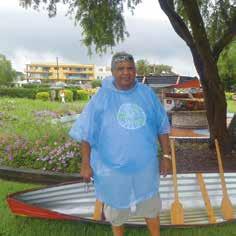


Canoes were central to traditional Aboriginal life here, for river crossings, fishing, storytelling and in ceremonies
much the same process would reward them with a bark canoe, providing the materials were pliable. The materials to build model nawi were laid out – damp stringybark, and strips taken from it as ties. Unlike paper, stringybark would actually float. David and the children then set about exploring the properties of the materials, turning the dampened bark inside out, and scraping the fibre off the outside of the bark.
Perhaps counter-intuitively, not only for children but adults too, it is the inside of the bark that becomes the outside of the canoe, since the resin-rich, inner surface of the bark on the tree allows for a more waterproof and smoother surface when inverted to become the exterior of the hull. This fact piqued the group’s interest as the bark was turned inside out to make a cylindrical shape. Each end was then pulled
together and tied with twine, by David and the workshop participants, concentration writ large on their young faces. Thwarts in the form of branches were placed across the boat to brace and hold the shape.
Last year Uncle Fred Kelly led his Dunghutti community to engage high school children while Kamilaroi elder Anthony Dennison is currently working with Birpai youths carving out a huge log to make a dug-out canoe. Another bark nawi will follow. The project’s three types of craft represent change and local adoption of new materials and techniques – the traditional tied-bark nawi; the dugout, which found its way down to this region from the north; and the later corrugated-iron craft. More than technology however, the craft embody the spirit of the local resurgence of pride and knowledge and are now used as teaching aids in the
01 Festival patron Jeremy Donovan and a tiedbark nawi surrounded by candle-carrying paper canoes – a message of reconciliation. Photography D Fletcher/ANMM
02 Saltwater Freshwater CEO Alison Page (centre) accepting a nawi model made in the workshop, with museum curators David Payne and Daina Fletcher.
03 Kamilaroi elder Anthony Dennison with the corrugated iron and bark nawi.
04 Blake of Barkindji and Kamilaroi heritage checking the lines of the bark model he helped make with David Payne.
05 Biripi elders Auntie Wilma Morcombe and Gloria Rowsell in the weaving tent.
community. We hope to see more of these canoes in Dunghutti country when the festival is held in Kempsey in 2014.
With tropical rain bursts thundering down, the festival spirit engaged all the senses. We enjoyed weaving ‘fish’ from lomandra or spiny mat rush with Rachel Piercy and the Worimi weavers, speaking with local artists and seeing their work, listening and talking in the yarn tent, laughing to the chattering bingo calls, dancing to the stellar line up of singers and musicians, and munching on roo burgers. And we sent messages of reconciliation in paper canoes alight with candles. This was a lovely echo of the real bark canoes – both of the historical past and the re-invigorated present – carrying fire on the water at night.
Daina Fletcher, senior curator

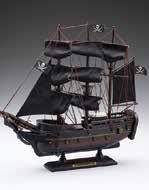

THE BLACK PEARL Made famous by the Pirates of the Caribbean, this jaunty model bristles with cannon and flies the Jolly Roger.
33 cm x 32 cm
$89.95 / $80.96 Members
WHITE STAR LINE TRINKET BOX
This is a replica of the First Class chinaware used on the White Star Line’s RMS Titanic. Note the 24K gold edging is the same as the original items.
$45.00 / $40.50 Members
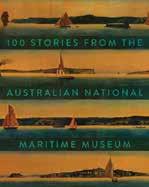

100 STORIES
The Australian National Maritime Museum’s curators reveal the fascinating stories behind the amazingly diverse collection of more than 130,000 items.
$39.95 / $35.96 Members
SEE INSIDE SHIPS
Lift the flaps to reveal the interiors of ships from across the ages, explaining what they were used for, how the crew and passengers lived, and how they sailed the oceans.
$24.00 / $21.60 Members
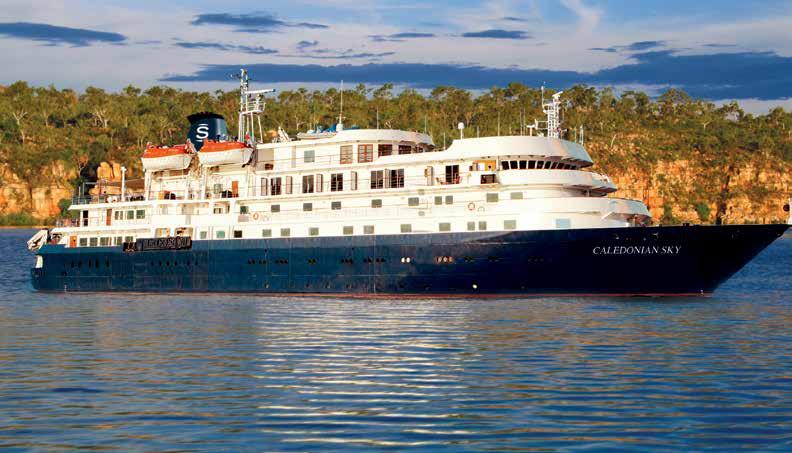
New for 2013, APT is launching a whole new way to explore the world’s seldom-seen treasures. APT’s Small Ship Expedition Cruises offer itineraries for those with a real sense of adventure, while maintaining the incredible standards for which we’re famous.
✓ The most luxurious expedition vessels –the MS Caledonian Sky and the MS Island Sky
✓ State of the art facilities resembling those of a private yacht
✓ Intimate, small group discoveries with just 55 suites
✓ Exquisite dining experiences with a touch of local flavours
✓ Included wines, beers and soft drinks with lunch and dinner
✓ Fleet of 10 Zodiac landing craft for a true exploration
✓ Onboard expedition teams with naturalists, historians & ecologists
✓ Freedom of Choice Sightseeing Inclusions throughout holiday


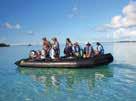


Comments or questions about Signals content?
Call the editor 02 9298 3647 email signals@anmm.gov.au
Signals is online
Search all issues from No 1, October 1986, to the present at www.anmm.gov.au/signals
Signals magazine is printed in Australia on Sovereign Satin 250 gsm(cover) and 128 gsm (text) usingvegetable-based inks on paper produced from environmentally responsible, socially beneficial and economically viable forestry source
Australian National
Maritime Museum
Open daily except Christmas Day
9.30 am to 5 pm (6 pm in January)
2 Murray Street
Sydney NSW 2000 Australia
Phone 02 9298 3777
ANMM council
Chairman Mr Peter Dexter am
Director Mr Kevin Sumption
Councillors
Mr Paul Binstead
Mr John Coombs
Rear Admiral T W Barrett am csc ran
Mr Peter Harvie
Mrs Robyn Holt
Dr Julia Horne
Mr Shane Simpson am
Ms Eva Skira
Mr Neville Stevens ao
Signals
ISSN 1033-4688
Editor Jeffrey Mellefont
Assistant editor Janine Flew
Staff photographer Andrew Frolows
Design & production Austen Kaupe
Printed in Australia by Pegasus
Print Group
Editorial and advertising enquiries
Jeffrey Mellefont 02 9298 3647 signals@anmm.gov.au
Deadline mid-January, April, July, October for issues March, June, September, December
Signals back issues
Back issues
$4 10 back issues $30
Extra copies of current issue $4.95
Call Matt Lee at The Store 02 9298 3698
Material from Signals may be reproduced, but only with the editor’s permission. The Australian National Maritime Museum is a statutory authority of the Australian Government.
Foundation Partner ANZ
Major Partners
Australian Maritime Safety Authority
Nine Entertainment
Southern Cross Austereo
Lloyds Register Asia
Toshiba Australia Pty Ltd
Project Partners
APT Group
APN Outdoor
Australian Museum
Coral Sea Wines
Destination NSW
NSW Parks & Wildlife
Ooh!
Royal Wolf Holdings Ltd
Silentworld Foundation
Sydney by Sail
Taronga Conservation Society
Universal Sony Pictures
Sydney Catchment Authority
Founding patrons
Alcatel Australia
ANL Limited
Ansett Airfreight
Bovis Lend Lease
BP Australia
Bruce & Joy Reid Foundation
Doyle’s Seafood Restaurant
Howard Smith Limited
James Hardie Industries
National Australia Bank
PG, TG & MG Kailis
P&O Nedlloyd Ltd
Telstra
Wallenius Wilhelmsen Logistics
Westpac Banking Corporation
Zim Shipping Australasia
ANMM GOV AU